#But this panel of Charles from the latest episode is so good
Explore tagged Tumblr posts
Text
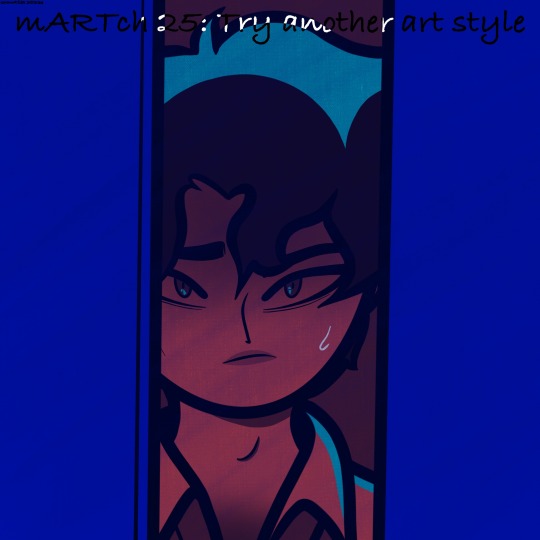

mARTch 25: Try a New Art Style (ft. a panel of the webtoon The Bind Prince)
#6#mARTch#mARTch2024#The Blind Prince#The Blind Prince Webtoon#Webtoon#I wanted to do a panel of Shiloh but I can’t measure up in the slightest#Just drawing Shane’s eye accurately intimidated me#But this panel of Charles from the latest episode is so good#He’s literally just looking out the door why#Anyway I also think this art style is more similar to mine.. RnF is very different#Anyway here’s Charles sir dude guy
16 notes
·
View notes
Text
"The Big Rip-Off"
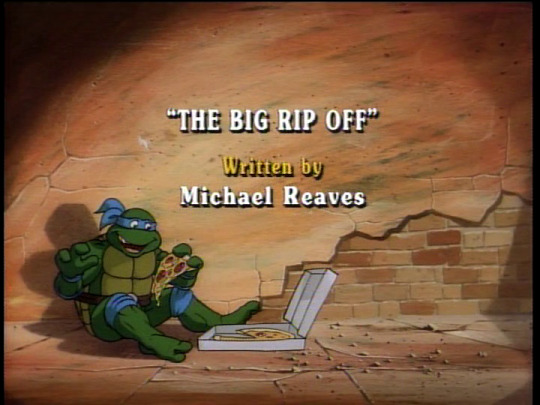
Season 3, Episode 45
First US Airdate: December 20, 1989 First BBC UK broadcast: May 8, 1992
The Turtles race to rescue April when she finds herself trapped in an air-tight vault.
We begin wrapping up season three of Teenage Mutant Ninja Turtles with "The Big Rip-Off", the first part of what's sometimes referred to as "The Big Trilogy". This is the last episode of the season written by Michael Reaves. Things are about to get good.
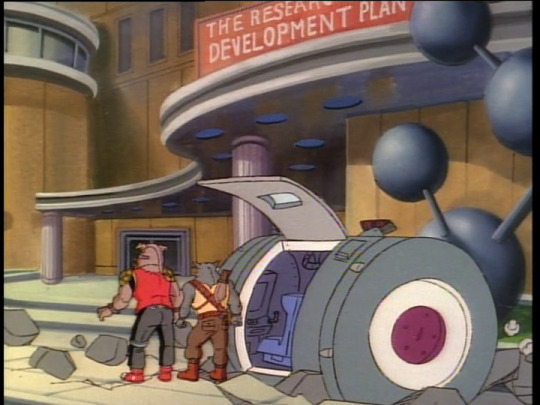
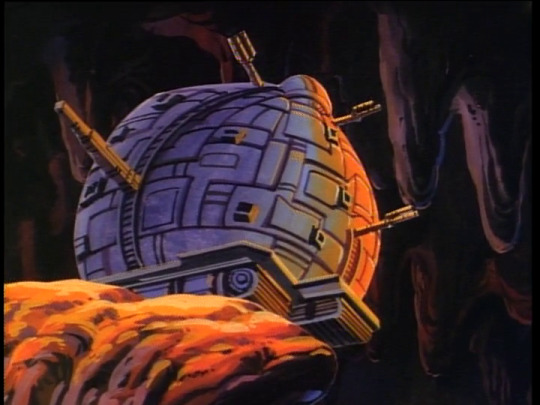
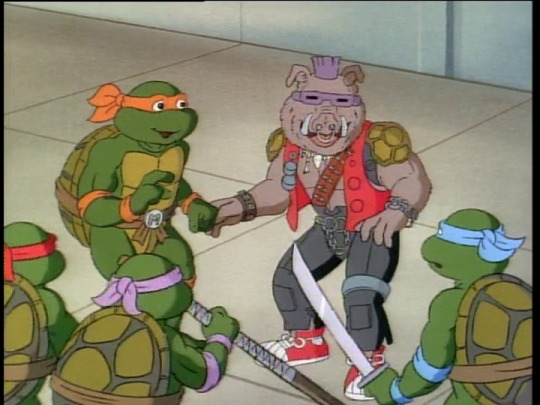
Rocksteady and Bebop are visiting “THE RESEARC[H AND] DEVELOPMENT PLAN[T]”. Once inside, they call back to Shredder in the Technodrome, which is now hanging over a very precarious ledge, a pool of lava waiting ominously beneath it. The mutants are given orders to steal energy modules that are desperately needed to keep the power on, but the Turtles are already waiting for them.
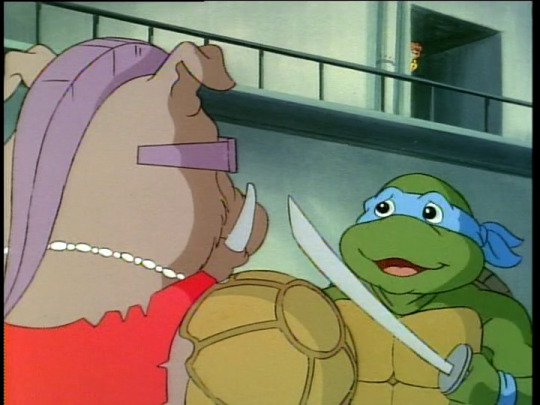
If it feels like we’ve been here a million times over the last year, rest assured that everyone working on the show is fully aware of how repetitive this setup has become; When Bebop questions how the Turtles knew they would be in this plant, Leonardo responds that it’s the only power plant in town they haven’t raided yet.
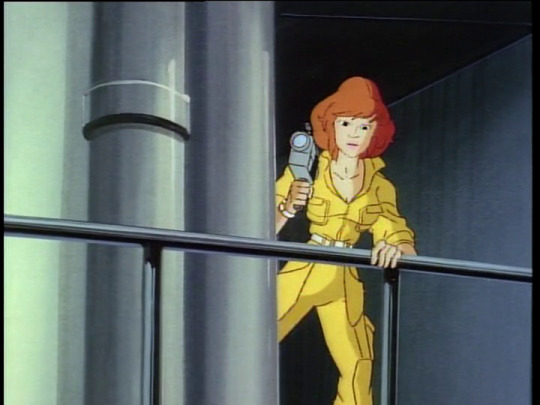
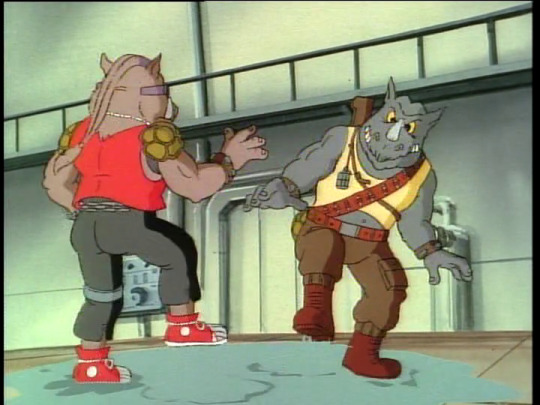
The Turtles, who in stark contrast to their portrayal in “Shredderville” are becoming increasingly smug about how easy all of this is, quickly place Bebop and Rocksteady on the defensive as April films everything from a distance. They drop glue on the floor that sticks to the feet of the bumbling duo, pinning them to the spot.
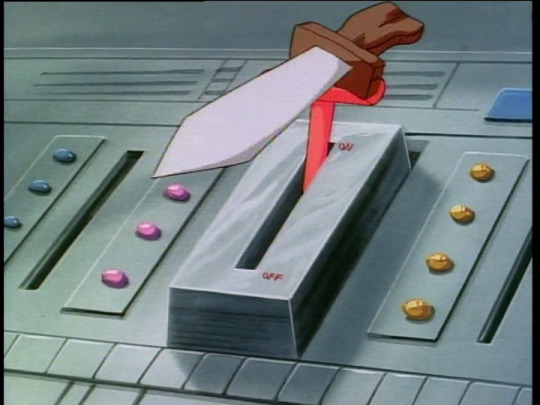
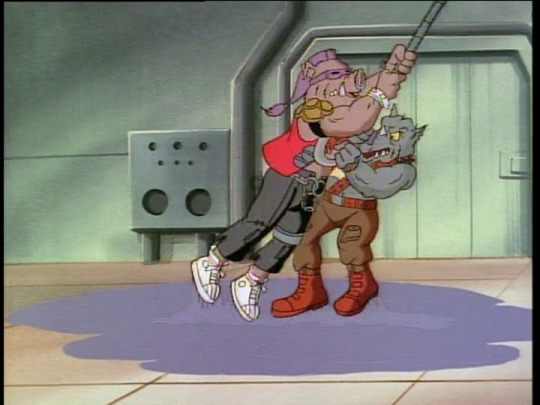
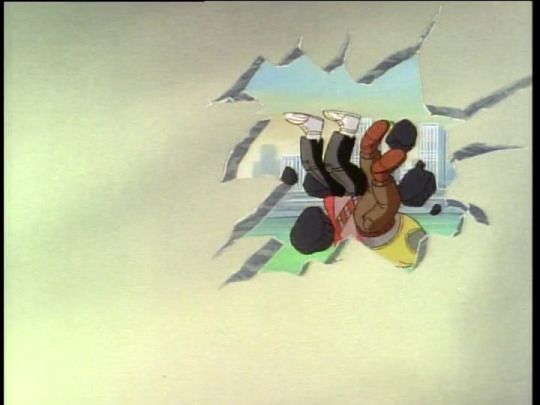
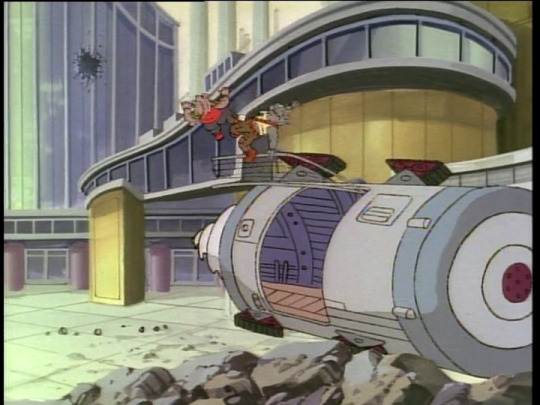
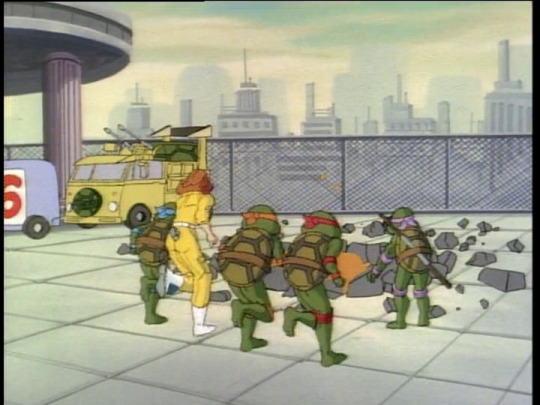
Rocksteady rebounds by hurling his sword at Leonardo. It misses, but just happens to hit a nearby control panel and activate a hook mechanism. The henchmen grab on and are dragged away from the sticky floor. They crash through the wall, bounce off the door of the transport module and hit the ground. Incredible. By the time the Turtles charge outside, the module is on its way back underground.
I should point out that during this battle, Krang affectionately referred to Rocksteady and Bebop as THE BOYS while in conversation with Shredder. It’s official and canon from this point onward.
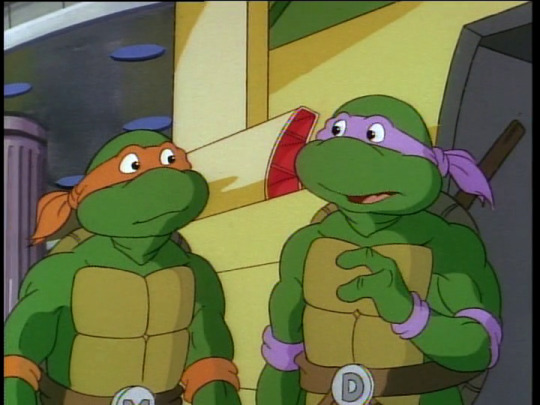
April mentions she’s on her way to report on the supercomputer security system being introduced at Fort Charles to guard a super energy source, but we’ll get back to that. Donatello suggests that Rocksteady and Bebop have been targeting energy facilities a lot recently; Michaelangelo retorts that “they’re after energy in every episode”, however Donnie speculates that their situation is worsening, the mutants now no longer even carrying their laser weapons. With this in mind, they determine that the fort may be their next target.
vimeo
The Boys return to the Technodrome to find Shredder wandering around with a candle chandelier, and have to make their excuses for their latest failure in one of the funniest scenes of the entire season. Krang points out that with the ledge beneath them continuing to crumble and with no power to maintain their refrigeration systems, things are becoming more dire by the minute.
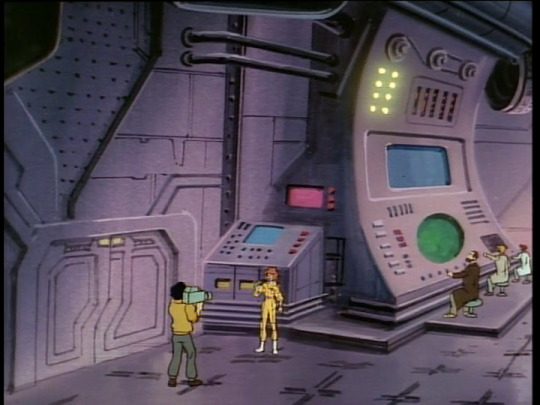
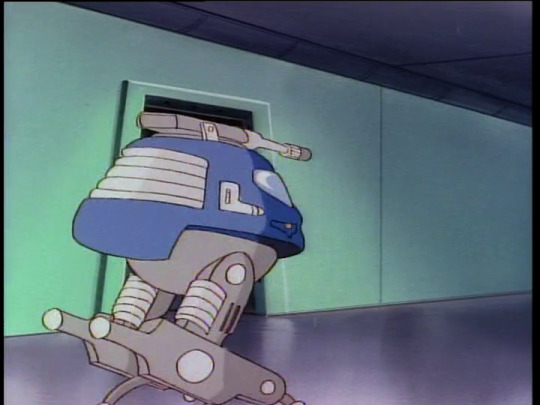
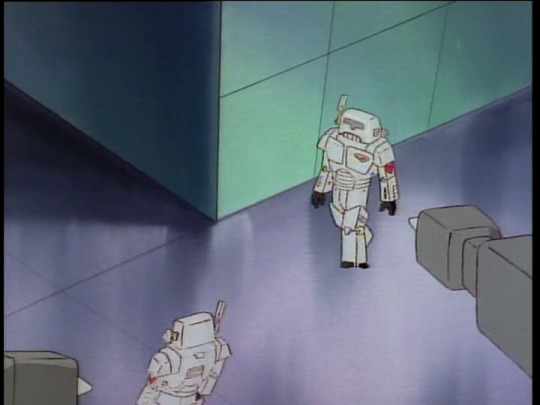
Back in the Lair, the Turtles watch as April films her report from the Fort’s storage center, “probably the most heavily fortified place on the face of the Earth”. Robots resembling ED-209 and Horde Troopers are seen wandering around, surrounding the installation’s supercomputer. Shredder and Krang watch the same report and learn of the Trilithium crystal stored in the vault. When Krang points out it would be impossible to get the crystal given how highly guarded it is, Shreds explains that he only wants the Turtles to think they’re attempting to steal it while they raid a different energy source elsewhere, and I’ve gotta say that after sixty-five episodes this is probably the smartest plan he’s ever had, one that actually has a degree of foresight for once.
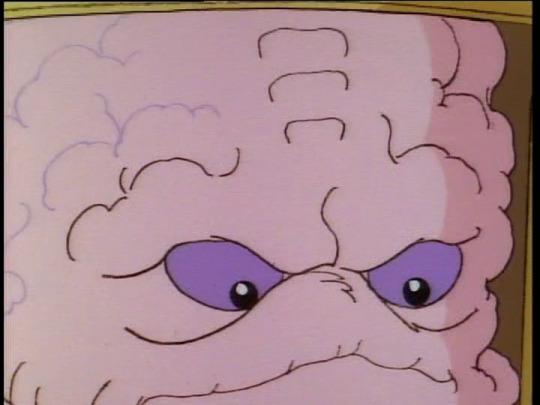
Krang remains sceptical as Shredder insists this will work. Again, after so many failures, I can’t really blame him.
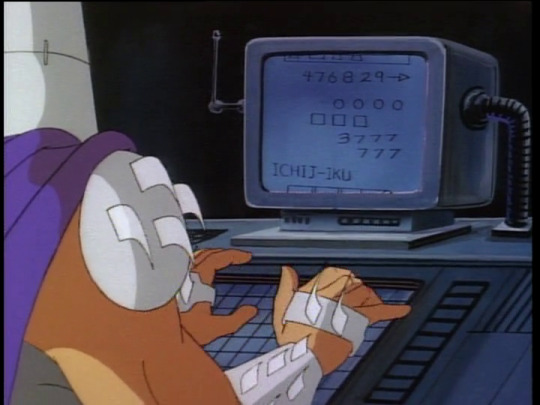
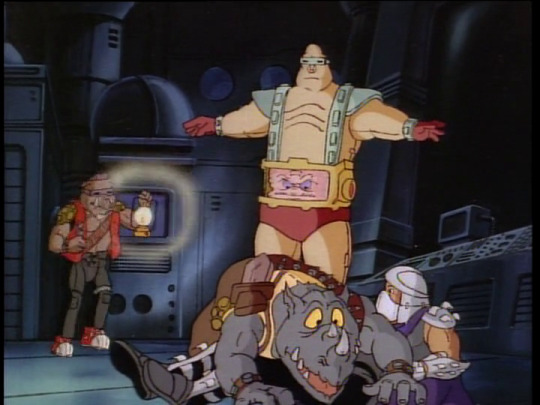
If the reveal a few episodes ago that Shredder was a master baker came as a surprise, he now goes on to reveal that he’s the greatest hacker to ever live, effortlessly logging into Fort Charles’s supercomputer in a matter of seconds and reprogramming it. Holy shit. He pulls off this feat just in time as the power fully goes out in the Technodrome seconds later, plunging the entire headquarters into darkness. Bebop emerges carrying a light to find Rocksteady sprawled across a fallen Shredder’s lap, before Krang chews out Shredder for using the last of their power on his hacking spree.
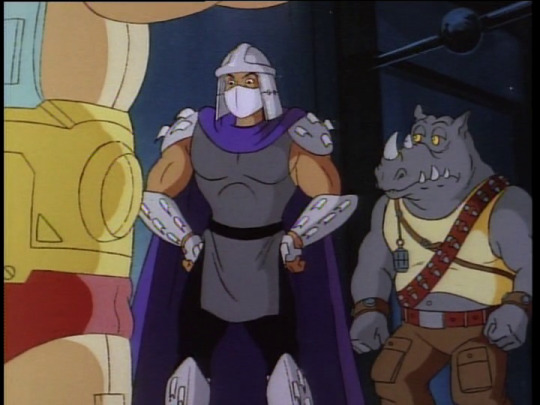
I’ve said in the past that this series isn’t so much about the Turtles as it is the story of a man whose ill-advised marriage to an alien brain led to him being lumbered with two doofus children. By this point it’s beginning to feel like the dad won’t stop squandering the last of the family’s money on hare-brained get-rich-quick schemes, and we’re all kind of holding out hope that maybe this will be the one that – almost literally – gets him out of the hole.
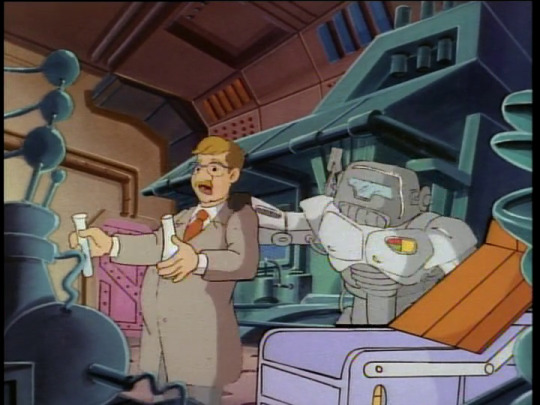
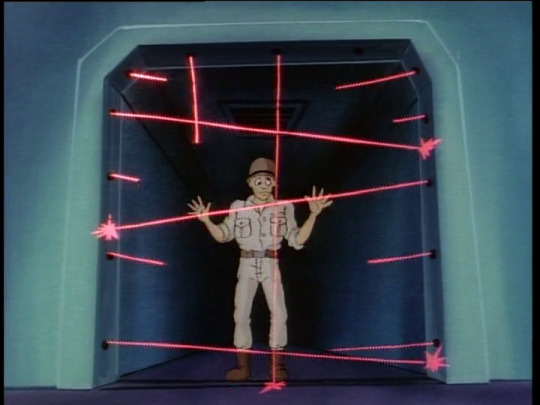
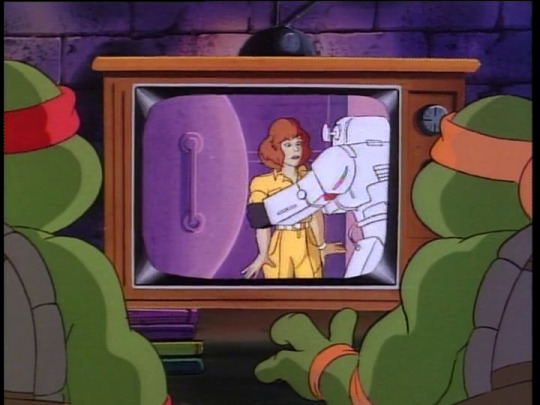
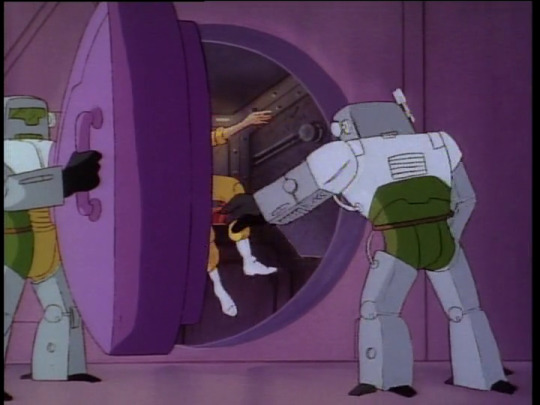
The fort’s robots, now reprogrammed, reconvene and begin hurling all of the human employees out of the building. April continues her live report and the Turtles watch on TV as the robots pick her up and hurl her into the vault. Donatello confirms that his suspicions were correct – Shredder has taken over the premises. The Turtles realise time is now of the essence, as April will suffocate if left for long enough inside the vault.

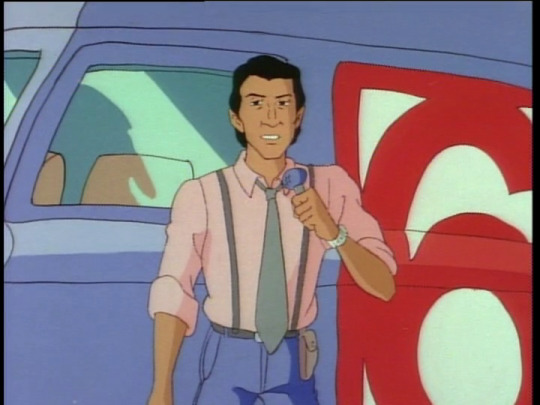
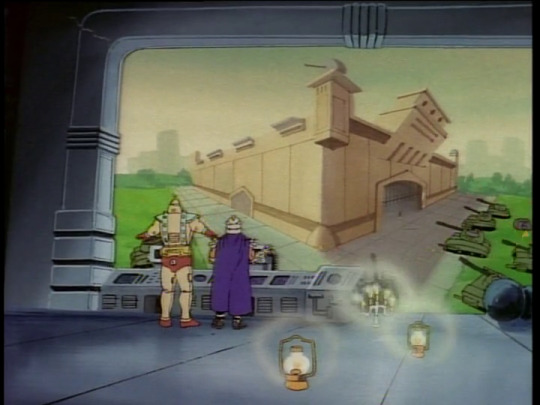
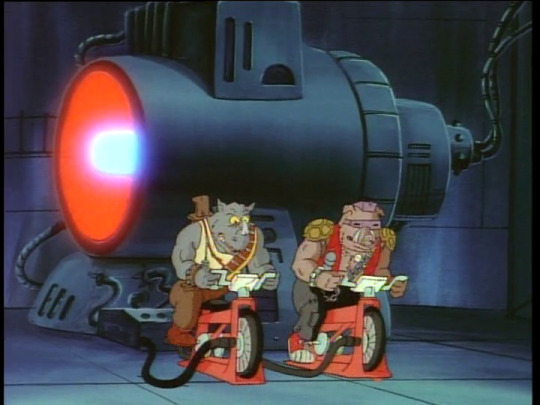
Act two opens with the Turtles racing on Cheapskates to the fort. While the military open fire from the outside, attempting to gain access, Vernon reports from the scene alongside Stan. Shredder and Krang watch this unfold from the Technodrome, their screen powered by Bebop and Rocksteady frantically pedalling on bikes.
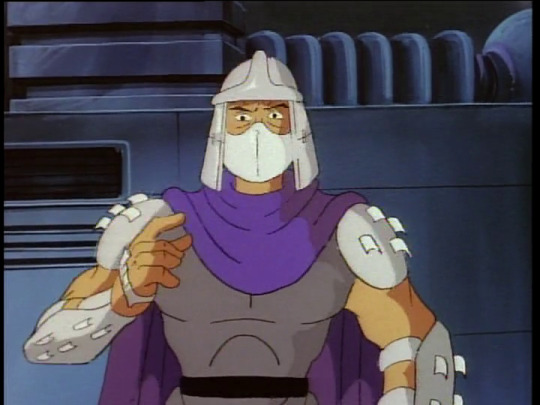
Shredder actually manages to get something resembling a compliment out of Krang as the quality of the art begins disintegrating by the second. He outlines the next step of his plan, ordering Rocksteady and Bebop to head to the Malik Missile Plant to get the supplies they need. Krang suggests that even Shredder’s mutants should be able to make this plan work, and that emphasis will become important later.
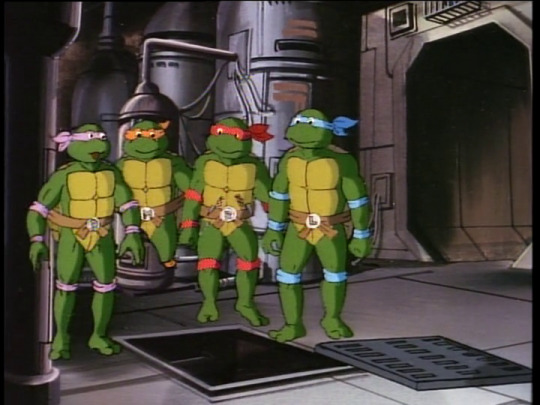
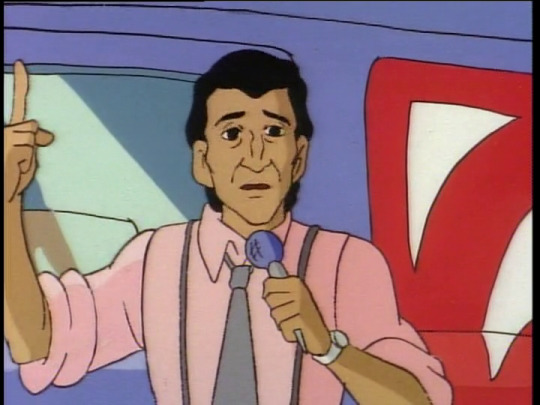
The Turtles use a sewer line leading directly into the fort – erroneously left unsecured by the military – to gain access, and quickly have to disable a nearby CCTV camera. Meanwhile, Vernon’s reports continue outside the building. He comments on the possibility that April might die if she’s not freed from the vault within the next hour, and promises that should this happen he’ll continue on in her place, quietly adding that he’ll get a raise for it too. Honestly, Vernon’s friction with April [and by extension Irma] has always been fairly petty stuff up to now; this, on the other hand, is low even for him.
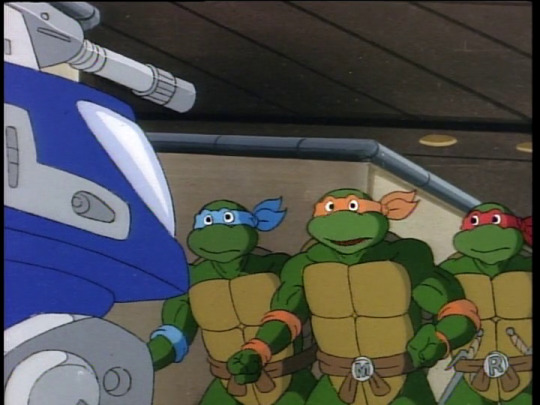

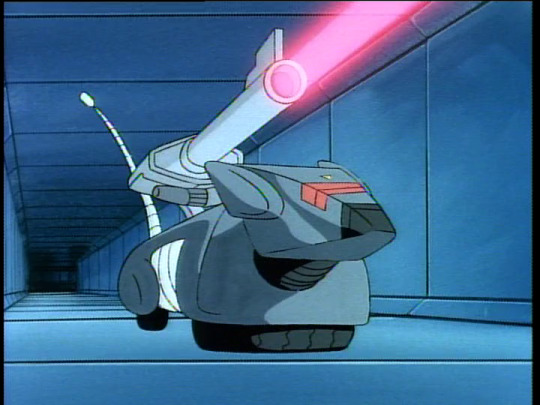
One of the ED-209s – let's be real, that’s effectively what they are – confronts the Turtles, and our heroes make a valiant effort to tackle it before realising this is a bad idea. They eventually retreat into a ventilation shaft in the roof only to find there are smaller robot drones patrolling this area too.
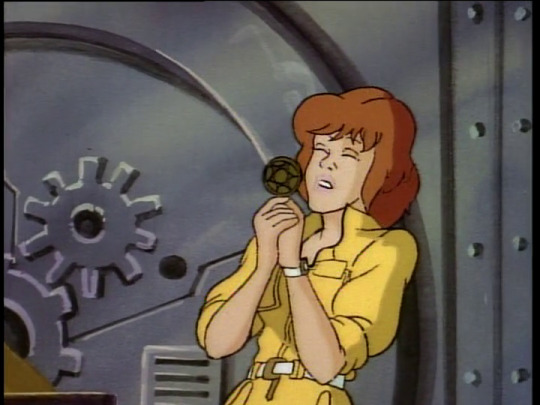
In the vault, April desperately tries to contact the Turtles via her Turtlecom, unable to breathe and unable to speak... at... normal... rate. This is another scene that looks like it was produced in an incredibly rushed manner, undermining what should be a rare moment of genuine peril in the series.
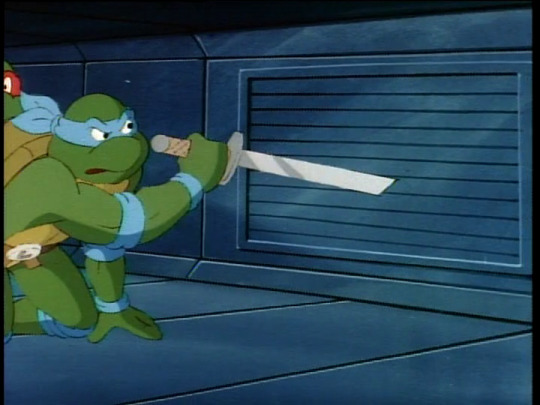
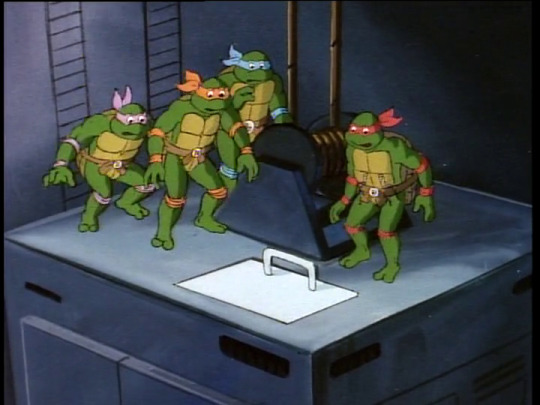

Leonardo uses his sword to carve a hole in a vent, allowing the team to drop down to a lower floor of the complex. Along the way, Donatello stops to remind the viewers not to try any of this at home. Just the absolute worst possible time for a “zany” fourth wall break.
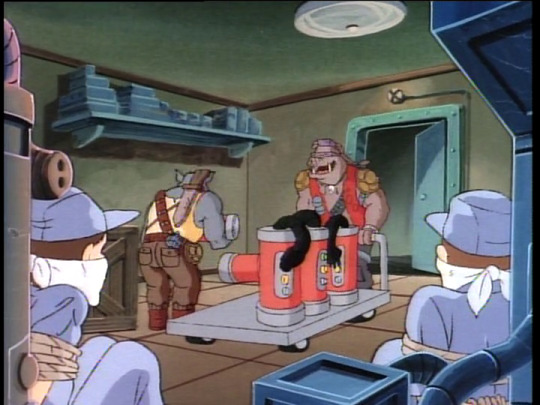
Across town, Bebop and Rocksteady are collecting the fuel cells they need without anyone intervening to stop them. They happily remark on how nice it is to be able to commit a crime without having to worry about the Turtles for a change. Good for them.
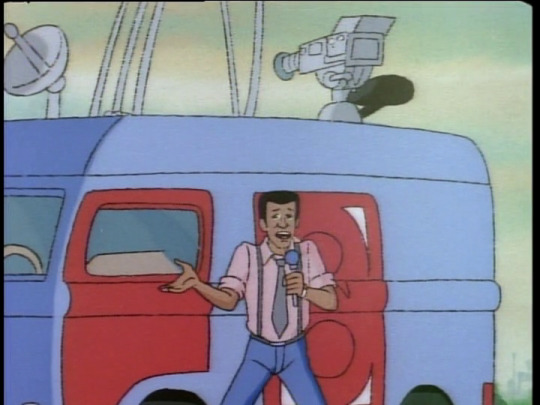
Vernon’s outside broadcasts continue with him talking himself up some more. He has a weird flat-top hairdo in the wide shots during this episode, because the season is almost over and everyone just wants to go home.
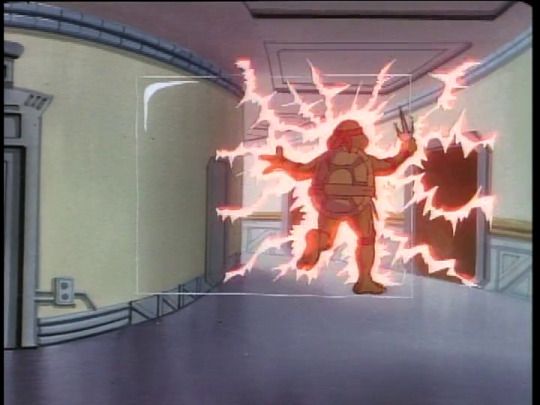

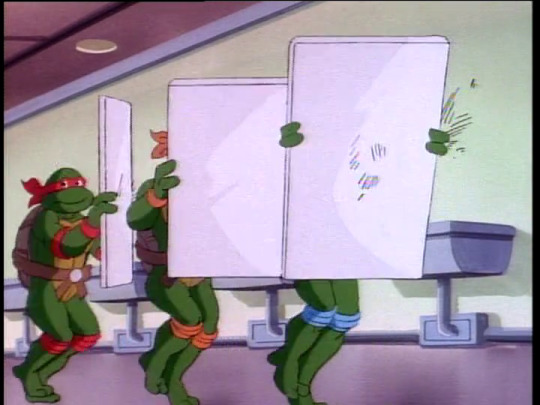
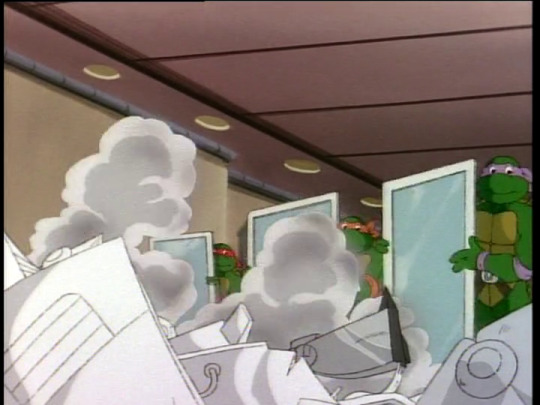
The Turtles continue to fight their way through the many traps dotted around the fort, as well as the waves of robots, but the odds prove overwhelming. Finally, Donatello has an idea, leading the team to the restroom (Raphael quips that he should have thought of this before they left). In a moment reminiscent of the end of The Turtle Terminator, the team lift mounted mirrors off the walls, and point them at the robots, the deflected laser beams quickly turning them into piles of scrap metal.
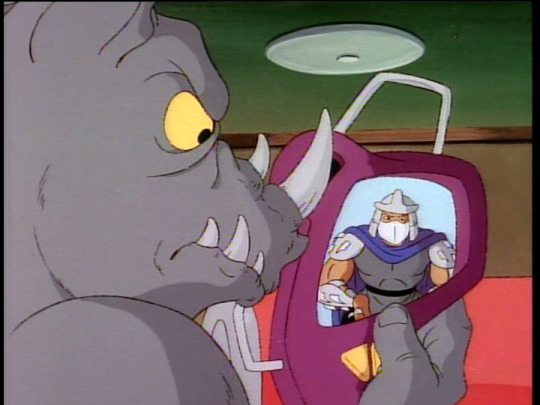
Shredder urges Rocksteady and Bebop to rush back to the Technodrome, figuring that once the Turtles realise they’ve been had, they’ll quickly head to the rocket plant. He goes on to ask Krang how he feels about getting a little exercise so they can get the viewscreens going again.
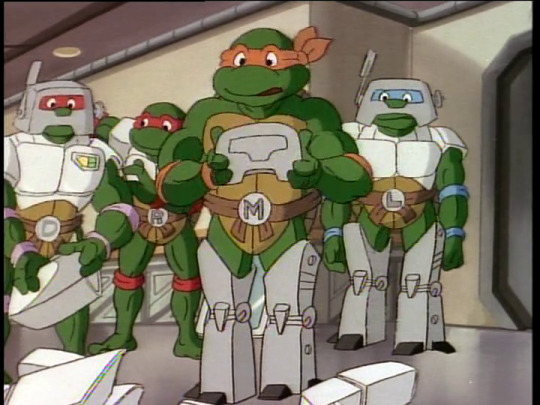
In the fort, the Turtles use the scrap parts to disguise themselves as robots so they can wander through the various sections of the building without attracting attention. This feels like a painfully drawn-out process; at the rate it’s taking them to get to the vault it’s a wonder April isn’t long dead already.
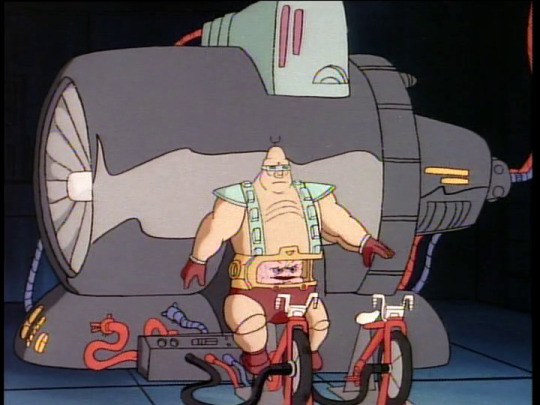

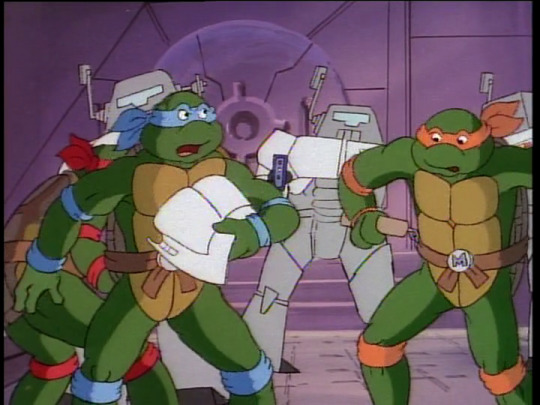
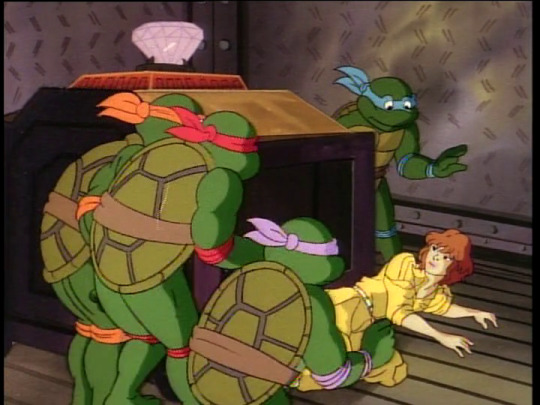
Back in the Technodrome, we witness a truly iconic TMNT moment, as Krang furiously pedals on one of the bikes to just about power up the viewscreen. He watches with Shredder as the disguised Turtles arrive at the computer’s control room. Our heroes stumble around in the least convincing fashion possible before being identified as intruders, eventually just saying “fuck it” and tossing their robot costumes aside. Donatello disables the computer, allowing the vault to be unlocked. Inside, April rightly asks the question “what took you guys so long?”
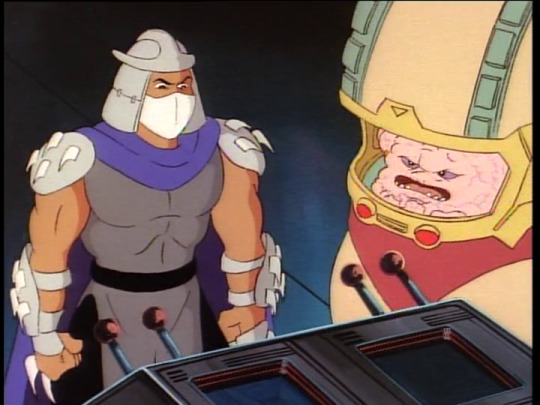
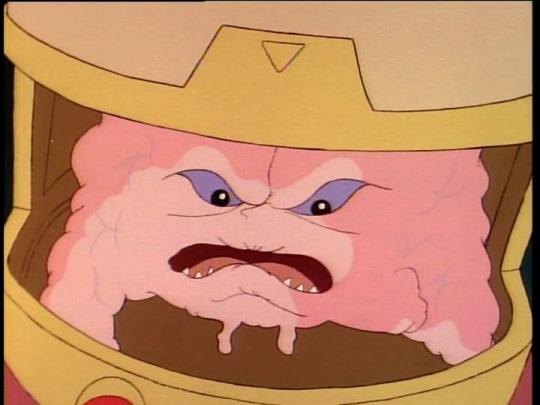
Krang and Shredder witness all of these events and note that the vault is now wide open, granting them easy access to the Trilithium crystal. Shreds points out that the crystal is too unstable, but Krang is insistent that he should go and try to take it anyway, on the basis that “your mutants are sure to fail”.
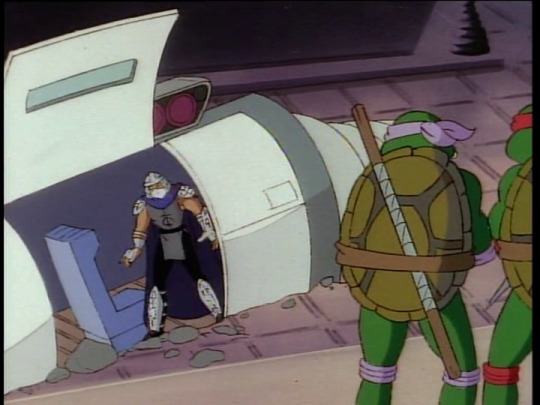
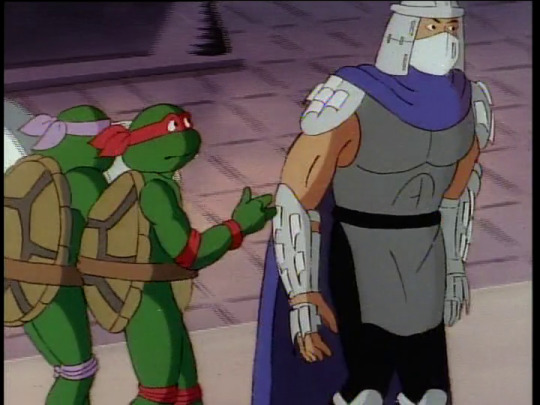
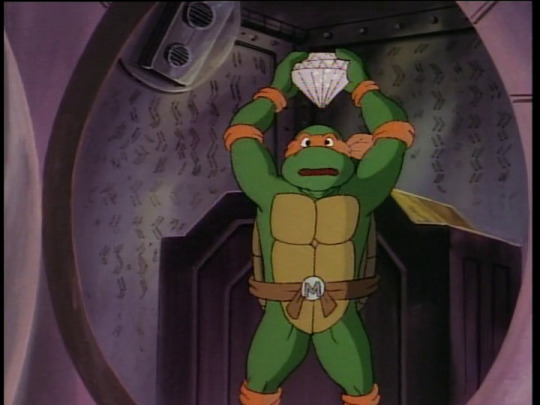
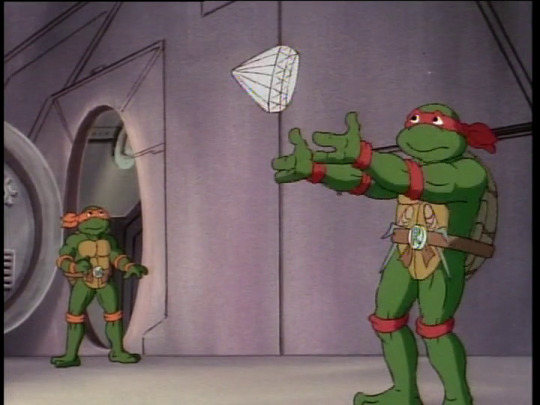
Moments later, a transport module pops up in the fort’s control room right in front of the Turtles. Shredder emerges and simply barges right past them, making a bee-line for the crystal. Michaelangelo blocks his path, grabbing the crystal for himself and threatening to hurl it despite Shredder’s protestations that it’s highly unstable. The Turtles begin hurling it between each other anyway, doing a very similar [American] football schtick to the one we saw at the climax of “Turtles at the Earth’s Core” earlier this season.
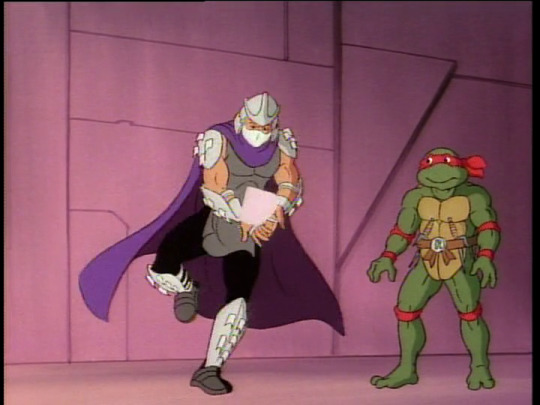
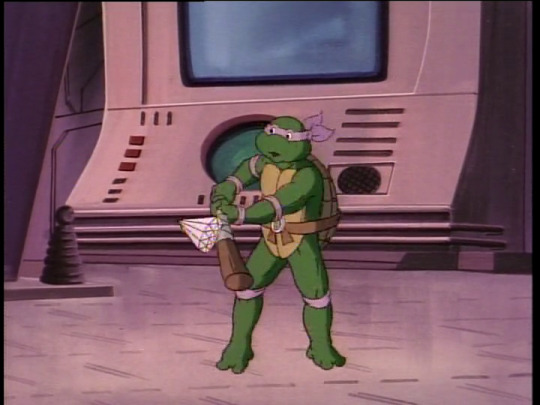
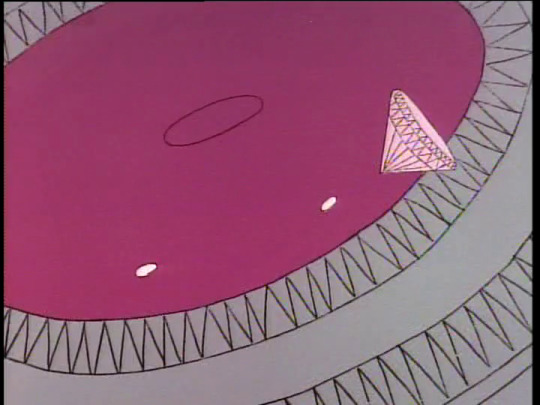
Deciding all of this is far more trouble than it’s worth, Shreds attempts to flee in his transport module, tossing the crystal away, but Donatello knocks it into the back of the module as it tunnels away. This feels like a good way to make sure that Shredder... is not alive... anymore. That’s definitely something other incarnations of the Turtles would be fine with, but these guys?
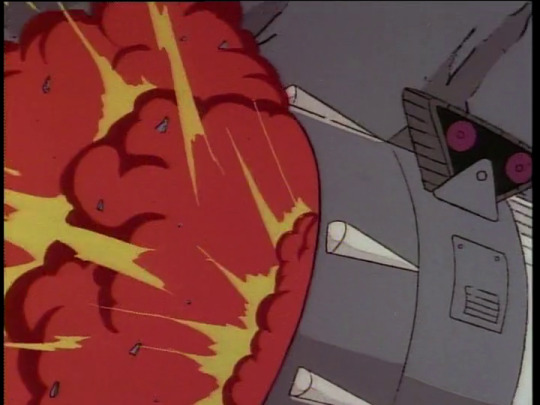
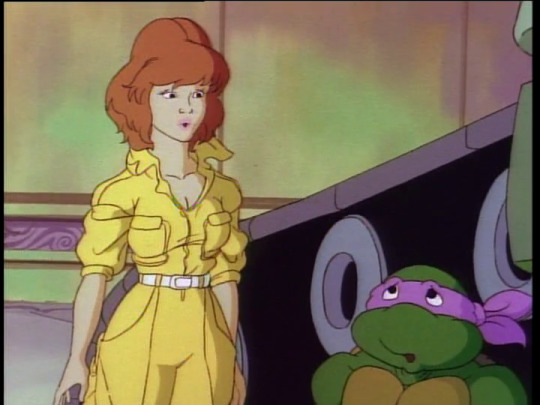
Sure enough, a huge explosion occurs in the rear of the transport module, one that’s big enough that the Turtles and April feel it above ground. Donatello suggests that whatever happened to Shreds, he hopes it’s nothing good. (Some real spite on display here too.)
The transport module and Shredder both somehow survive and crash back into the Technodrome. Shreds is stunned to find the lights on, and a happy Bebop & Rocksteady have returned to greet him. Krang explains that The Boys obtained the energy needed from the rocket site; thanks to his mutants, the Technodrome’s systems are now at full power.
This might be where you’re expecting some kind of punchline; somehow, Bebop and Rocksteady will have messed up, and there’ll be some sting in the tale that ruins everything, sending our resident bad guys right back to where they started. But no.
vimeo
They did it. Rocksteady and Bebop successfully completed a mission and have revived the Technodrome. Do you believe in miracles? The Isotopes win a game! The Isotopes win a game!
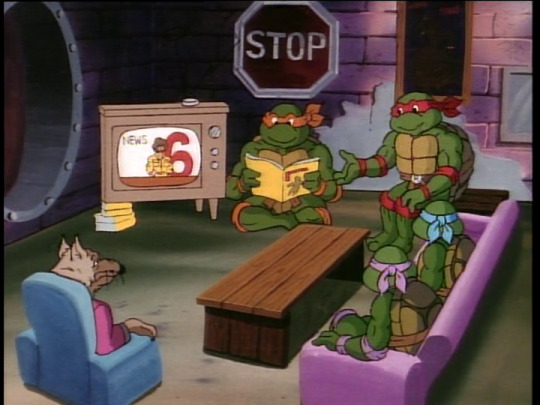
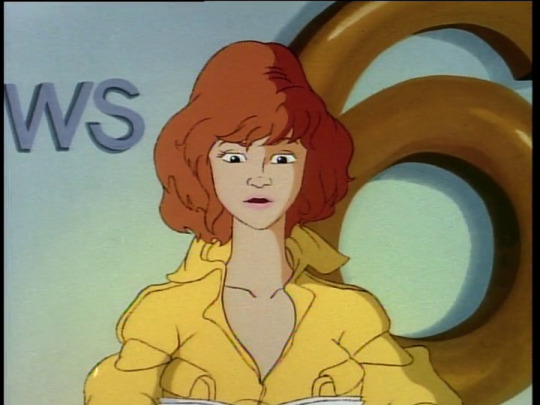
The Technodrome is seen pulling away from the cliff edge it was dangling over before we cut back to the Lair. The Turtles are arrogantly mocking their foes, scoffing at the idea that they’ll ever revive the Technodrome when April breaks the news on TV of the raid on the rocket plant. This is all played for laughs, but let’s not allow them to diminish Rocksteady and Bebop’s moment of triumph.
Michael Reaves has contributed some stellar episodes throughout this season, his best work up there with that of David Wise. While I have some quibbles with how this story was handled – April being in genuine mortal danger is the one time the Turtles absolutely should not be doing flippant quips and talking to the kids at home – I still consider this to be a top-tier, landmark episode. For one of the first times ever, it feels as if there are genuine stakes, that things are progressing a little beyond the status quo, and that the villains have a glimmer of competency. The Turtles working through waves of traps and robots feels like something from one of the TMNT video games played out in animated form, and the jokes – at least from the villains – all land.
The writing for this episode is so strong that it somehow makes up for the often-woeful images appearing on-screen throughout. There are frequent sequences where characters devolve into a blobby mess, and while there are well-done moments dotted throughout (Bebop delivers an anecdote about the tooth fairy during the rocket plant raid where some wonderful character work shines through), there’s a sense that the wheels are now long gone from the cart and everyone is doing their best to push it over the finish line.
NEXT TIME: The rise of the Technodrome in “The Big Break-In"!
#Teenage Mutant Ninja Turtles#TMNT#TMNT 1987#1989#The Big Trilogy#The Big Rip-Off#Turtlethon#Ninja Turtles
5 notes
·
View notes
Photo
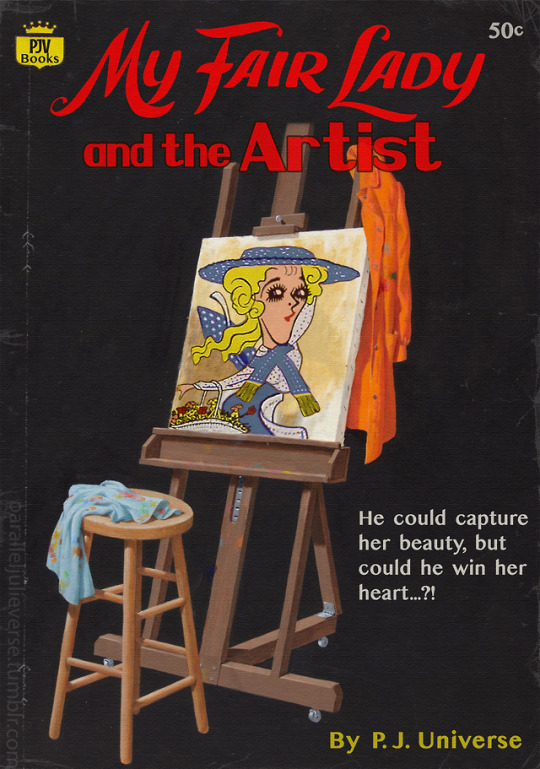
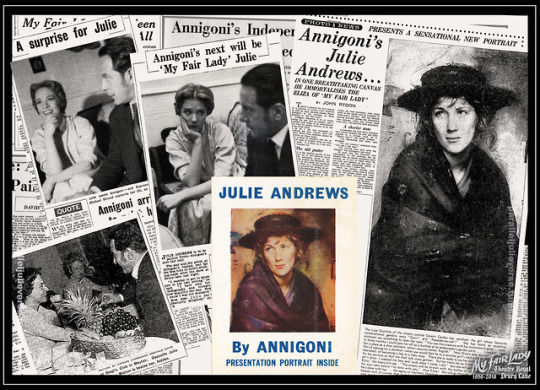
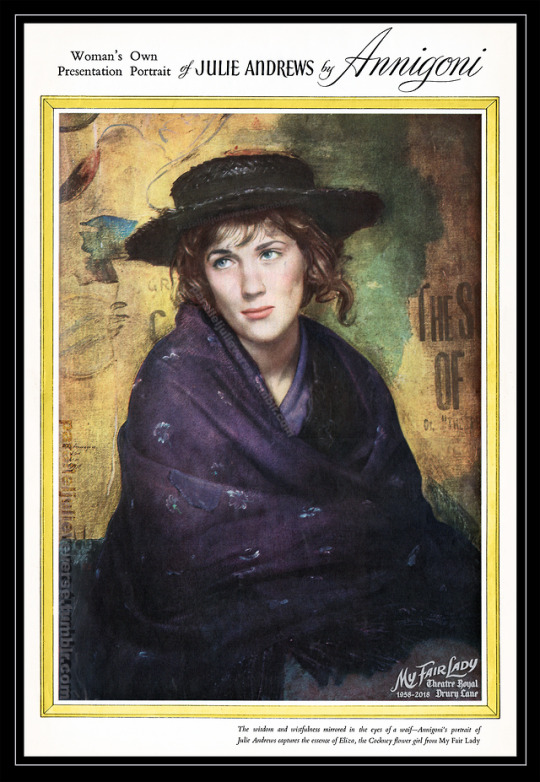

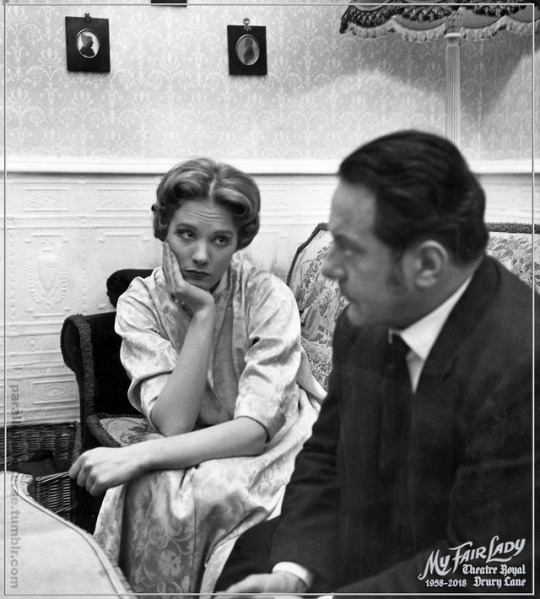
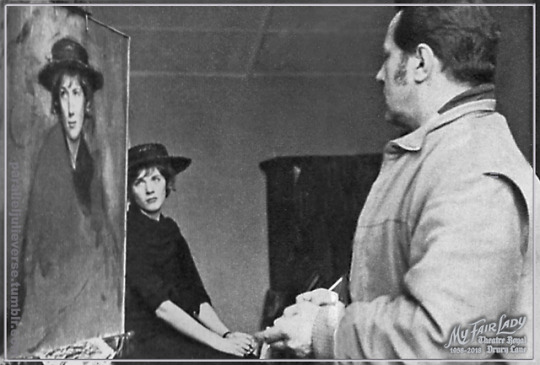
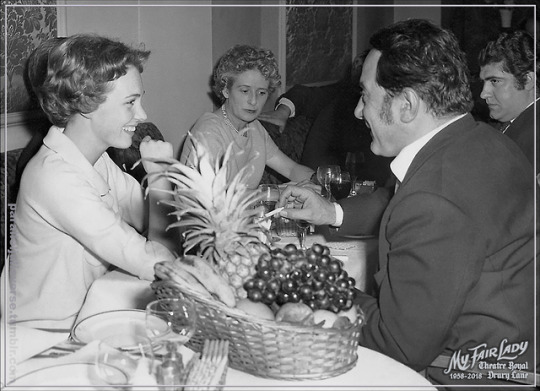

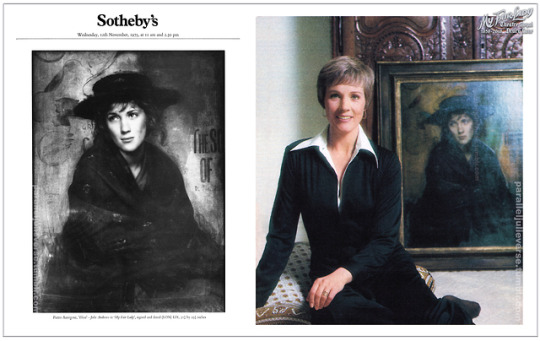
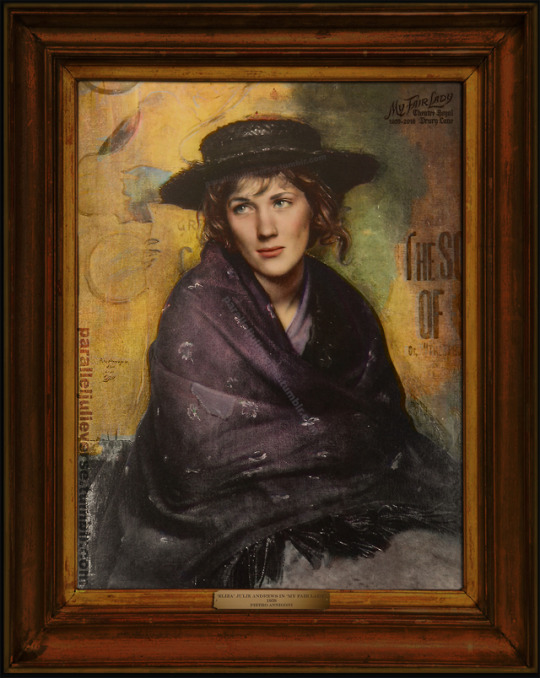
“One day I’ll be famous. I’ll be proper and prim...”
Sixty years ago, more or less to the week, the famed Italian painter Pietro Annigoni unveiled his latest masterwork: ‘Eliza’, Julie Andrews in ‘My Fair Lady’ (1959).
At the time, Annigoni was the most celebrated portraitist in the world. His dreamily romantic 1954-55 oil of Queen Elizabeth II catapulted the hitherto little known Italian painter to international fame (Wynne-Morgan: 17). Almost overnight, Annigoni became "the most sought-after portrait painter of the decade” (Shearer: 4) attracting a glittering line-up of celebrity subjects including Princess Margaret, Prince Philip, the Duchess of Devonshire, the Shah and Empress of Iran, the Maharani Gayatri Devi of Jaipur and Margot Fonteyn. His services were so in demand that he reportedly “had to refuse thousands of commissions –– 90 out of every 100 ––as the queues of VIPs waiting to be immortalised stretched around the world” (Turner: 8).
It was against this backdrop that Julie Andrews’s longtime manager, Charles ‘Uncle Charlie’ Tucker, approached Annigoni in 1958 with an invitation to paint his client who was riding triumphant at the time as the star of My Fair Lady. Tucker made the approach via a mutual friend –– Max Farber, an American newspaper editor and PR man who handled publicity for Annigoni’s first US exhibition in 1957 (Randolph: 6) –– which no doubt helped seal the deal (”Surprise”: 7). In his memoirs, Annigoni (1977) recalls:
Although I hardly knew who Julie Andrews was then, I agreed, but nearly a year went by before I was able to start the portrait. On the day I arrived in London, the manager Charles Tucker, took me to see the show and to meet the young actress. I was pleasurably surprised by both and decided there and then to paint her in the costume and character of Eliza Doolittle, the show’s Cockney flowergirl (121).
The meeting of these two disparate celebrities –– the serious, gruff Continental painter and the trilling English Rose –– was the stuff of PR dreams and it drew considerable media attention. “There’s no need to say she is very pretty,” Annigoni is reported to have remarked as he sized up his subject in her backstage dressing-room, “But I expect I shall need some 30 sittings before I am satisfied” (”Surprise”: 7).
In the end, Julie went to sit for the artist at his Chelsea studio exactly 28 times between April and June 1959 (Rydon: 5). Following these sessions, Annigoni would continue to work on the painting for hours, often late into the night. Ever the perfectionist, he even arranged for a copy of Julie’s flower-girl costume to be sent over from Drury Lane and worn by a model so he could hone the finishing touches (ibid.).
Throughout the more than two month period of the portrait’s production, Julie continued to perform in My Fair Lady, as well as prepare for her wedding to Tony Walton in mid-May. It was a pressured schedule that inevitably led to the odd timing mishap, a source of great irritation to the exacting Annigoni. When, on one occasion, Julie arrived at his studio more than twenty minutes late, the artist was so enraged he refused to answer the door, necessitating a diplomatic flurry of contrite telephone calls to smooth his ruffled ego (Andrews: 258; Annigoni: 121). “He was an arrogant man,” Julie recounts, “the epitome of the temperamental artist” who “demanded total dedication and punctuality” (Andrews: 258).
For all his irascibility, Annigoni in his memoirs looked back fondly on Julie as “a very sweet girl” (Annigoni: 121). He was especially grateful when, after complaining of a pain in his right arm, Julie arranged for a special house call from Tony Walton’s doctor-father who diagnosed “a cracked humerus” and “treated it successfully” (122). Annigoni was, by all accounts, equally pleased with the portrait itself, quietly considering it to be one of his finer works (Rydon: 5).
Once the commission was complete and the portrait delivered, the enterprising Tucker set about negotiating the sale of reproduction rights to select newspaper and magazine outlets. It was a canny move that not only helped recoup much of the initial £2000 commission fee but ensured optimal publicity for both the portrait and its star (Annigoni: 122). Images of the painting were carried in the international press as far away as Australia (“Annigoni’s Fair Lady”: 122). In October, Tucker licensed Woman’s Own –– a high-circulation magazine that had previously published several stories on Annigoni –– to run a lavish full-colour centrefold “presentation copy” of the portrait (”Star Feature”: 29-31). This special issue was strategically timed to coincide with the PR lead-up to Julie’s four-part BBC TV series in November/December 1959, the first episode of which featured Annigoni as a celebrity guest (Cottrell: 126). Tucker also floated plans –– ultimately unrealised, alas –– for future portraits of Julie as Guinevere in Camelot and “all the different characters of every show she has been in” (Private Correspondence to Max Farber, 21 April 1959; see also “’My Fair Lady’ Star”: 4).
As with much of Annigoni’s work during this period, the Julie Andrews portrait was well received by the public and middlebrow commentators –– “a breathtaking canvas” (Rydon: 7); “surely will rank...in the future with the famous ‘Mona Lisa’" (Cartmel: 16) –– but it proved far less pleasing to ‘serious’ art critics. Indeed, for the most part, the arts intelligentsia of the day took a pretty dim view of Annigoni. The artist’s predilection for representational classicism, coupled with his vocal opposition to then fashionable traditions of abstract modernism, made him an "isolated anachronism” in the post-war arts scene and a frequent target of critical scorn (Turner: 8). Many critics dismissed Annigoni as little more than a technically-accomplished draughtsman, a “purveyor of Old Masterish pastiche” (Rogers: 96).
When the Julie Andrews portrait was shown at the annual Royal Academy Summer Exhibition in 1960, many reviews were openly derisive. “I suppose it has a faded Victorian charm,” sniffed The Observer (Clutton-Brock: 19). “Signor Pietro Annigoni’s Julie Andrews in My Fair Lady...belong[s] in every fibre to the times and dull skill of late Victoriana,” echoed the Daily Mail (Jeannerat 1960: 7). While The Stage huffed: “With his oil of Julie Andrews in My Fair Lady, Pietro Annigoni could not have been more conventional and unexciting if he had tried with all his might” (”Not Much”: 21).
The intervening passage of time and the resurgence of interest in figurative portraiture has afforded a less jaundiced view of Annigoni and his place in art history. Following the artist’s death in 1988, his work was subject to a growing critical reassessment that saw him redeemed as an important figure of twentieth-century ‘classical realism’ (Lack: 50-59). A 1995 feature-length documentary mounted a passionate defence of Annigoni as “a prolific and complex artist...a philosopher with the skill to capture a person’s soul” (Bond and Smith). Major retrospectives of his work have since been held around the world and in 2008 a dedicated Annigoni museum was inaugurated in the artist’s native Florence.
It is a context that encourages renewed consideration of Annigoni’s portrait of Julie Andrews as a serious artwork. Pace knee-jerk dismissals of it as mere decorative Victoriana, close reading reveals that, beyond the attractive veneer –– what one critic sneeringly termed “the prettiness of the chocolate-box” (Jeannerat 1961: 3) –– lies a work of considerable intelligence and interpretive depth. For all his technical realism, Annigoni approached the practice of portrait painting as effectively that of an expressive character-study. “I have always painted to please myself,” he declared, “and interpret the sitter as I see and understand [them]” (Shearer: 4). A good portrait needs to be accurate but also communicative, he believed, an expression of character and moral quality beyond the mere impression of outward appearance. It’s an approach that orients his portraits to structural and conceptual duplexity: “he captures the soul of beautiful women...but he also catches the deeper side” (Sullivan: 92).
Here, it is worth recalling the ‘official’ title of Annigoni’s portrait of Julie: ‘Eliza’, Julie Andrews in ‘My Fair Lady’ (Jackson: 84). It suggests that, far from a simple depiction of a single physical subject, the portrait is in fact a complex study of plural subjects. It ‘portrays’ Julie Andrews –– in technically consummate, if idealised, likeness –– but in the guise of Eliza Doolittle, a celebrated character as reimagined in a contemporary hit musical. There are thus three interacting spheres or layers of representation in the work: real person, fictional character, and theatrical role. Looking at the portrait, the observer’s mind moves inexorably between all three, posing an interpretive conundrum: are we looking at an actress in character or a character as realised by an actress?
Taking the idea of layering further, the portrait, like much of Annigoni’s work, is quite literally a work of layers. As part of his commitment to traditionalism, Annigoni was noted for his exacting use of Quattrocento production techniques. Chief among these was the practice of tempera grassa whereby an artwork is painstakingly created on a chalk-gessoed panel through composite layers of pigment mixed with a binding agent, typically egg and oil, interspersed with coats of lacquer (Cookson: 43ff). It is a labour-intensive form of stratified image-construction that lends Annigoni’s paintings their characteristic luminosity with dynamic hues and complex interplay of shadows and light. It also enhances their disarming trompe l’oeuil effect where minutely detailed realism –– limpid eyes, flesh flushed with sanguine warmth, textured fabric–– and precise geometric perspectivalism combine to simulate a sense of perceptual depth that draws the eye in and across the painting’s spatial field and its various objects (Hoopes: 21).
Annigoni’s portrait work is equally characterised by a parallel layering of compositional form. Much like his Renaissance masters, the artist typically sets his subjects in and against a background rich with symbolic import. His celebrated 1954-55 painting of the Queen, for example, was as famous for its romantic depiction of the young monarch resplendent in her ceremonial robes as for the fact that she appears Diana-like towering triumphant over a sylvan English landscape at misty dawn, gazing into “the light of...a new Elizabethan age” (Wynne-Morgan: 17).
In the case of the Julie Andrews portrait, Annigoni chose to depict his subject against a backdrop of peeling theatre posters. Such was the importance of this background to Annigoni’s vision that he reportedly scoured London to obtain historical playbills from the very date Shaw’s original production of Pygmalion, the source text for My Fair Lady, opened at His Majesty’s Theatre on April 11, 1914 (Rydon: 5). Cracked and peeling in burnished hues of faded gold and green, the backdrop is clearly redolent of age and historical memory. In fact, the curled strips of paper look not unlike autumn leaves falling with the passage of time. Combined with the work’s classical style and bronzed patina, it strikes a decided note of wistful, even melancholic, longing. But what redeems the endeavour from being a simple exercise in sentimental nostalgia –– a common criticism of Annigoni’s work –– is that this elegiac reference to times-gone-by sits within a broader frame of markedly mixed temporalities.
In a way that neatly parallels the painting’s fusion of representational levels mentioned above, the portrait conjoins past, present and future in convoluted, and ultimately irresolvable, ways. Out of the golden past of Edwardian theatrical history, Shaw’s Eliza –– herself a resurrection of the ancient Greek figure of Galatea –– is reborn anew in My Fair Lady, the contemporary hit show of the painting’s ‘present’ in the late-1950s. That she is embodied here in the form of Julie Andrews, a then-tender 23-year old on the cusp of global superstardom, adds additional layers of futurity to the mix –– as does the fact that Annigoni chose to paint Julie in Eliza’s early flower-girl guise where she is still dreaming of an as-yet-unknown “loverly” tomorrow.*
The multi-levelled temporality of the portrait was not lost on commentators at the time of the painting’s unveiling:
Annigoni has painted Julie Andrews, who created the leading musical ‘My Fair Lady’ but it is Shaw’s eternal Eliza (46 years old next year––the first performance was in April 1914) who shines through...The portrait was commissioned by Miss Andrews’ manager, Mr Charles Tucker. The woebegone waif, clutching her purse shawl, with her melting mouth and a tear n her cheek, will hand in house. Until he dies. He has willed the portrait to Miss Andrews, a legacy of her first fame (“Annigoni’s ‘Fair Lady’”: 122).
This 1959 prediction as to the ‘future’ of the portrait was close to the spirit, if not quite the letter, of what transpired. After hanging for many years in Tucker’s London office, the painting was eventually put up for auction at Sotheby’s in late-1975 where it generated considerable interest (Hickey: 9).* Following spirited bidding, the painting sold at fall of hammer to an anonymous bidder for £7000 (£60,000 in inflation adjusted prices) (Jackson: 84; Walker: 11). The bidder was subsequently revealed to be a proxy advocating on behalf of Blake Edwards who had bought the portrait as a gift for his wife. So, in the end, ‘Eliza’, Julie Andrews in ‘My Fair Lady’ came back full circle to its subject who, in her own words, is “thrilled to own it and it hangs in my home” (Andrews: 258).
Notes:
* Some commentators have pointed out that the portrait contains another coincidental allusion to the star’s future as one of the playbills glimpsed in the background appears to spell out the half-hidden words: The Sound of... “How prophetic!” notes Julie (Andrews: 258).
** Several sources, including Annigoni himself (1977: 122), state that the painting was put up for sale by Tucker’s widow after his death. The Sotheby’s catalogue does indeed list “Mrs Charles L. Tucker” as the lot consignor but Tucker was still alive in 1975––he passed four years later in 1979––so his wife’s name was possibly used for taxation purposes (”Obituary”: 6). In her memoir, Julie alludes to the fact that she and Tucker had a gradual professional alienation which resulted in a change of management sometime in the mid-60s (Andrews: 221). She also mentions apropos the auction that: “I heard that Charlie asked whether [the portrait was being bought] on my behalf, and he seemed happy when the fact was confirmed” (Andrews: 258).
Sources:
Andrews, Julie. Home: A Memoir of My Early Years. London: Weidenfeld & Nicolson, 2008.
Annigoni, Pietro and Wright, Robin. An Artist’s Life. London: W.H. Allen, 1977.
“Annigoni’s Fair Lady.” The Sydney Morning Herald. 11 October 1959: 122.
Bond, Richard and Smith, Stephen. Annigoni: Portrait of an Artist [DVD], Italy/Canada: Artatak/Rainbow Films, 1994.
Cartmel, Frank B. “Splendid.” Daily Express. 1 October 1959: 16.
Clutton-Brock, Alan. “New Non-Conformists.” The Observer. 1 May 1960:18-19.
Cookson, Dawn. Painting with Annigoni: A Halcyon Decade as a Student in Florence 1958-68. London : Unicorn Press, 2000.
Cottrell, John. Julie Andrews: The Story of a Star. London: Arthur Barker, 1968.
“Fair Deal.” The Guardian. 13 November 1975: 6.
Hickey, William. “Under the Hammer: Annigoni’s Fair Lady.” Daily Express. 29 October 1975: 9.
Hoopes, Donelson F. Pietro Annigoni: A Retrospective Exhibition. New York: Brooklyn Museum, 1969.
Jackson, Anne, ed. Art at Auction, The Year at Sotheby Park Bernet, 1975-1976. New York: Rizzoli, 1976.
Jeannerat, Pierre. “Christ at Cookham...the Epitaph of Genius.” Daily Mail. 29 April 1960: 7.
_________. “Just Chocolate (Annigoni flavour) Likenesses.” Daily Mail. 26 April 1961: 3
Lack, Richard. "Classical Realism: The Other Twentieth Century," Utne Reader. July /August 1989: 50-59.
Laws, Frederick. “Annigoni’s 1961 Old Masters So Depressing.” Daily Herald. 26 April 1961: 39.
McIlhany, Sterling. “Pietro Annigoni: Contemporary Florentine Master.” American Artist. 36: 359, June 1972: 24-30.
“’My Fair Lady’ Star Seen as Fairest of Them All.” The Age. 18 November 1959: 4.
“Not Much at the Academy.” The Stage. 5 May 1960: 21.
“Obituary: Charles L. Tucker Dies; Impressario [sic].” Hartford Courant. 14 May 1979: 6.
Randolph, Nancy. “Chit-Chat.” Daily News. 11 December 1957: 6.
Rogers, Malcolm. From Elizabeth I to Elizabeth II: Master Drawings from the National Portrait Gallery. London: Art Services International, 1993.
Shearer, Lloyd. “The Ladies Love His Portraits.” Parade. 5 January 1958: 4.
“Star Feature: Annigoni’s Portrait of Julie Andrews.” Woman’s Own. 3 October 1959: 29-31.
Sullivan, Robert. “Pietro Paints the Queen.” Daily News. 5 June 1955: 92.
“Surprise for Julie: Annigoni arrives to paint her.” Daily Express. 16 April 1959:
Turner, Francesca. “Annigoni: Isolated Anachronism.” Evening Post. 9 May 1977: 8.
Walker, John. “Meet...Understated Superstar.” Observer Magazine. 6 June 1976: 10-11.
Welles, John. “Meet Julie Andrews: Understated Superstar.” The Observer Magazine. 6 June 1976:
Wynne-Morgan, David. “Painter of the Queen: Annigoni, a Dazzling Story of Success.” The Age Literary Supplement. 15 December 1956: 17.
Zeri, Federico. Italian Paintings: Florentine School: A Catalogue of the Collection of the Metropolitan Museum of Art. New York: MMA, 1971.
© 2019 Brett Farmer All Rights Reserved
#julie andrews#Pietro Annigoni#My Fair Lady#eliza doolittle#portrait#artist#charles tucker#musical theatre#west end#Broadway#1959#art#painting
22 notes
·
View notes
Link
Since next week we’ll be going into full New Kickstarter mode for the Pirates of Pugmire KS, let me catch up on a few things we talked about in the Monday Meeting today, and expand on our thinking about attending conventions.
First, thanks to everyone who sent in questions for my interview with the Onyx Pathcast! We had a great recording session last week that, no surprise, ran extra long. So many things to cover, and I wanted to go into enough detail to deliver more than a corporate sound-bite.
Next, yes, I’m still all fuzzy-headed from pollen allergies. Thanks to all who asked, or provided solutions – medical or otherwise!
And, as far as I’ve been informed, all the backer rewards for the Scion Kickstarter should now be out in the trucks/planes/tricycles of the shippers our fulfillment shipper works with. USPS and Fedex mostly, but these days it is hard to pin that down as they all seem to subcontract with each other.
V5 Chicago art by Amy Wilkins
In a little over two weeks, Eddy, Mighty Matt McElroy, and myself, will be flying over to Merrie Olde Englande for UK Games Expo! This is going to be extremely cool for me, as my family pretty much all came from that part of the world, and I’ve never visited before.
Plus, we’ll be hanging out with Matthew Dawkins, and meeting Steffie de Vann, John Burke, Chris Allen, and Klara Herbol face-to-face for the first time! We are good at using other methods of talking together like Skype, and generally love the virtual office thing, but hanging out and getting to know our creators is still the best way to really understand each other.
But our kumbaya moments aren’t all we’ll be doing at the con! The gang are running all sorts of demo games, including a Chronicles of Darkness tournament where they’ll be running games for the CofD game lines and one player will advance to a special session of the Contagion Chronicle run by developer Matthew Dawkins!
This is a kind of connected con game we’ve never actually done officially before, and we’re really looking forward to how things play out! Plus, the are a lot of other demo games going on including Fetch Quest and Prince’s Gambit, for those who need a card game break from their roleplaying sessions.
I’ll be in meetings and podcasts and other interviews, but hope to get a chance to sit near, if not in, and enjoy the fun. So if you’re going, and want to chat, you can stop by the Onyx Path booth and find out where we all are if you can’t find us there.
One thing you won’t find there will be us selling games and books at the booth. We’re stepping away from making the booth a sales venue at UKGE, and we’ll be directing folks who want to buy our stuff to our friends at Leisure Games! In fact, here’s a handy map now of the exhibition floor:
Now, UK Games Expo is not the only convention we are trying out this new booth strategy with. In fact, we are going all in at Gen Con 2019, this year, and we’re not having any booth at all there.
Instead, we have pretty much doubled the number of demo games that will be run there, we’re still having our Onyx Path panels, and you’ll still be able to buy our games and books and stuff at the Studio2 and Indie Press Revolution booths.
Unsurprisingly, we have a map for that too!
But Rich, why? Why not carry on the tradition of the Gen Con booth? You guys have made a big deal out of your Gen Con planning every year since Onyx Path started (even a few years before that, actually).
The answer is in the question really. It has been a big deal. A huge deal.
One that sucked up our time, effort, planning, attention, and cash. Gen Con exerted a disproportionate gravity every year for the effect it had on our company and community. As a chance to see the same folks year after year, the booth was a great focal point – one we are going to try and move to the panels and demo tables.
I never saw the booth as a “sales venue” nor wanted us to drive it in that direction. That’s just not how I’ve thought of our presence there; it was always more of a communications opportunity. But what we’ve seen these past few years is that the need for the booth to be our big chance to talk to folks has really been left in the dust by our online presence.
For example, all last year at Gen Con, I heard from both new and long time members of our community how they love the Onyx Pathcast, or chatting with Dixie on Slack, or Matt and Ian on our Facebook pages.
And this hasn’t just affected the booth. For example, we used to get a huge reaction when we released the new Onyx Path Brochure at Gen Con – now folks have told us that they already know most of what’s in there because of our social media and these very Monday Meeting Notes blogs, so we’ll be debuting a new kind of brochure at the Mid-Winter Convention this year.
Shunned By The Moon art by Jeff (Silver Fox) Holt
Once we looked at all that; really went into the different ways that folks are getting info and a chance to connect with the company, we could see that the booth was a massive drain on our time in terms of running it, and a pretty big drain on cash that we could use in more proactive ways, and that there were better ways we could use to communicate.
Put that all together, and we’re going to try doing things sans booth this year and see what happens. Maybe it is a horrible idea. We’ll see. But if we just “do what we’ve always done” without examining those strategies to see if they are effective, we’re headed for the tar pits.
And nobody wants that. We want to evolve so that we can continue to deliver you:
Many Worlds, One Path!
BLURBS!
KICKSTARTER:
Our Pirates of Pugmire Kickstarter will be starting at 2pm Eastern US time on Tuesday, May 21st!
ONYX PATH MEDIA
Illustration by Charles Bates
On this Friday’s Onyx Pathcast is a special Pirates of Pugmire Design Diary pretty much totally by Eddy Webb, who has been recording sessions all through his process of developing PoP: https://onyxpathcast.podbean.com/
And Here’s More Media About Our Worlds:
No Onyx Path News from last week as Matthew was away, so expect a special edition this week to make up for the gap! As for actual plays, it seems to be a Scarred Lands-focused week! Please let the Gentleman Gamer on the Onyx Path Forum know if you have an actual play or review you’d like us to profile, new or old!
Onyx Path‘s YouTube channel has however gained an additional two parts of the Scarred Lands actual play Matthew is running for Red Moon Roleplaying. Check it out if heists, dragons, asaathi, and slitherin are your thing! https://youtu.be/cjbkpGHZhVM
The Story Told RPG Podcast have reached episode five of their Dragon-Blooded actual play, so if you’re interested in Exalted, please give it a listen: http://thestorytold.libsyn.com/fall-of-jiara-episode-5-a-dinner-to-remember
The latest episodes of Occultists Anonymous, the Mage: The Awakening actual play (with crossover elements are synopsised as follows: Episode 11: Across the Abyss. Half the cabal, twice the fun. They attempt to summon a Supernal being… Without any research! https://youtu.be/3y3ws45deyw AND Episode 12: Magical Girls’ Night. The conclusion of the summoning, and new plans are laid to develop tools to spellcasting. https://youtu.be/VgaxzDivbMc Give them a watch!
Back to Scarred Lands now, and Caffeinated Conquests‘ actual play of the Gauntlet of Spiragos continues (and they completely off-track from the published scenario): https://youtu.be/haNoWVTBjLc
Returning here to Scarn with Travis Legge’s Myths & Matchmakers, which has reached its 20th episode! If you enjoy your actual plays, please do check this channel out. Also, Travis really knows his Scarred Lands: https://www.youtube.com/watch?v=DYIfQKyR5Vs
Devil’s Luck Gaming are always worth checking out for their fantastic Scarred Lands and Chronicles of Darkness actual plays, streamed live: https://www.twitch.tv/DevilsLuckGaming
The Keeper of the Archive (a new show on YouTube) has recently made lengthy strides into covering the Traditions of Mage: The Ascension (https://www.youtube.com/playlist?list=PLAmGl_jV_qwLk33I706Dfxg3RTqPd6YGz) and Tribes of Werewolf: The Apocalypse (https://www.youtube.com/playlist?list=PLAmGl_jV_qwKLTkw8JkX02zkOMzbtrS8k). It’s a new channel and they’d greatly appreciate your support
One of our frequent Mage freelancers, Rachelle Udell, was recently interviewed by Mage: The Podcast on the subject of the Mage Cookbook and other subjects! It’s well worth a listen, and an excellent channel in general: https://anchor.fm/mage-the-podcast/episodes/The-Mage-Cookbook-and-the-Ahl-i-Batini-with-Rachelle-Udell-e3tr3g
Please check any of these out and let us know if you find or produce any actual plays of our games!
ELECTRONIC GAMING:
As we find ways to enable our community to more easily play our games, the Onyx Dice Rolling App is now live! Our dev team has been doing updates since we launched based on the excellent use-case comments by our community, and this thing is both rolling and rocking!
Here’s an update from the App devs:
We’ve been having trouble fixing the android bug that messes up the resolution for newer phones. I think we have a fix for that. It was also brought up that the store display is wrong on most tablet devices, so that is getting fixed too. That should all be soon!
ON AMAZON AND BARNES & NOBLE:
You can now read our fiction from the comfort and convenience of your Kindle (from Amazon) and Nook (from Barnes & Noble).
If you enjoy these or any other of our books, please help us by writing reviews on the site of the sales venue you bought it from. Reviews really, really help us with getting folks interested in our amazing fiction!
Our selection includes these fiction books:
OUR SALES PARTNERS:
We’re working with Studio2 to get Pugmire out into stores, as well as to individuals through their online store. You can pick up the traditionally printed main book, the Screen, and the official Pugmire dice through our friends there! https://studio2publishing.com/search?q=pugmire
We’ve added Prince’s Gambit to our Studio2 catalog: https://studio2publishing.com/products/prince-s-gambit-card-game
Now, we’ve added Changeling: The Lost 2nd Edition products to Studio2‘s store! See them here: https://studio2publishing.com/collections/all-products/changeling-the-lost
Scarred Lands (Pathfinder) books are also on sale at Studio 2: https://studio2publishing.com/collections/scarred-lands
Looking for our Deluxe or Prestige Edition books? Try this link! http://www.indiepressrevolution.com/xcart/Onyx-Path-Publishing/
And you can now order Pugmire, Monarchies of Mau, Cavaliers of Mars, and Changeling: The Lost 2e! http://www.indiepressrevolution.com/xcart/manufacturers.php?manufacturerid=296
DRIVETHRURPG.COM:
On Sale This Week!
This Wednesday, we’re putting up a ton of stickers on our RedBubble store! Symbols and logos and art and all sorts of stuff- but as stickers!
CONVENTIONS
UK Games Expo: May 31st – June 2nd From the US comes Eddy Webb, Matt McElroy, and Rich Thomas to join with Matthew Dawkins, Steffie de Vann, John Burke, Chris Allen, and Klara Herbol! Gen Con: August 1st – August 4th Save Against Fear: Oct 12-14 GameHoleCon: October 31st – November 3rd We’ll also be back at PAX Unplugged later this year.
And now, the new project status updates!
DEVELOPMENT STATUS FROM FAST EDDY WEBB (projects in bold have changed status since last week):
First Draft (The first phase of a project that is about the work being done by writers, not dev prep)
M20 Victorian Mage (Mage: the Ascension 20th Anniversary Edition)
Geist2e Fiction Anthology (Geist: The Sin-Eaters 2nd Edition)
Exalted Essay Collection (Exalted)
Scion: Demigod (Scion 2nd Edition)
Trinity Continuum Jumpstart (Trinity Continuum Core)
Masks of the Mythos (Scion 2nd Edition)
Wraith20 Fiction Anthology (Wraith: The Oblivion 20th Anniversary Edition)
One Foot in the Grave Jumpstart (Geist: The Sin-Eaters 2e)
Dragon-Blooded Novella #2 (Exalted 3rd Edition)
Exigents (Exalted 3rd Edition)
Terra Firma (Trinity Continuum: Aeon)
Titanomachy (Scion 2nd Edition)
Crucible of Legends (Exalted 3rd Edition)
Redlines
Legendlore core book (Legendlore)
Monsters of the Deep (They Came From Beneath the Sea!)
Tales of Aquatic Terror (They Came From Beneath the Sea!)
Scion: Dragon (Scion 2nd Edition)
Kith and Kin (Changeling: The Lost 2e)
Second Draft
Tales of Good Dogs – Pugmire Fiction Anthology (Pugmire)
Dragon-Blooded Novella #1 (Exalted 3rd Edition)
Across the Eight Directions (Exalted 3rd Edition)
TC: Aeon Ready Made Characters (Trinity Continuum: Aeon)
Mummy: The Curse 2nd Edition core rulebook (Mummy: The Curse 2nd Edition)
City of the Towered Tombs (Cavaliers of Mars)
Heroic Land Dwellers (They Came From Beneath the Sea!)
DR:E Threat Guide (Dystopia Rising: Evolution)
DR:E Jumpstart (Dystopia Rising: Evolution)
TC: Aeon Jumpstart (Trinity Continuum: Aeon)
Development
Hunter: the Vigil 2e core (Hunter: the Vigil 2nd Edition)
WoD Ghost Hunters (World of Darkness)
Oak, Ash, and Thorn: Changeling: The Lost 2nd Companion (Changeling: The Lost 2nd)
Night Horrors: Nameless and Accursed (Mage: the Awakening Second Edition)
Memento Mori: the GtSE 2e Companion (Geist: The Sin-Eaters 2nd Edition)
M20 The Technocracy Reloaded (Mage: the Ascension 20th Anniversary Edition)
Creatures of the World Bestiary (Scion 2nd Edition)
Heirs to the Shogunate (Exalted 3rd Edition)
Scion Companion: Mysteries of the World (Scion 2nd Edition)
Deviant: The Renegades (Deviant: The Renegades)
Chicago Folio/Dossier (Vampire: The Masquerade 5th Edition)
Let The Streets Run Red (Vampire: The Masquerade 5th Edition)
Cults of the Blood Gods (Vampire: The Masquerade 5th Edition)
Manuscript Approval:
Trinity Continuum: Aberrant core (Trinity Continuum: Aberrant)
Pirates of Pugmire (Realms of Pugmire)
Blood Sea: Crimson Abyss for 5e (Scarred Lands)
Editing:
Spilled Blood (Vampire: The Requiem 2nd Edition)
CofD Dark Eras 2 (Chronicles of Darkness)
Distant Worlds (Trinity Continuum: Aeon)
Scion Ready Made Characters (Scion 2nd Edition)
Lunars: Fangs at the Gate (Exalted 3rd Edition)
Post-Editing Development:
M20 Book of the Fallen (Mage: the Ascension 20th Anniversary Edition)
V5 Chicago By Night (Vampire: The Masquerade)
V5 Chicago By Night Screen (Vampire: The Masquerade)
CofD Contagion Chronicle (Chronicles of Darkness)
Witch-Queen of the Shadowed Citadel (Cavaliers of Mars)
Indexing:
Trinity Aeon
ART DIRECTION FROM MIRTHFUL MIKE:
In Art Direction
Ex3 Monthly Stuff
Chicago By Night
They Came From Beneath the Sea!
EX3 Lunars
Hunter: The Vigil 2
Contagion Chronicle
VtR Spilled Blood – Contracted.
M20 Book of the Fallen – Contracted.
Dark Eras 2 – First set of sketches in.
CoM – Witch Queen of the Shadowed Citadel – Sending back feedback on sketches.
Pirates of Pugmire – KS art contracted, sketches and finals coming in.
Trinity Continuum: Aberrant – KS art started contracting.
Scion Ready Made Characters – Contracted.
TC Aeon: Distant Worlds – Reading through artnotes.
Marketing Stuff
In Layout
Dystopia Rising: Evolution – With Josh.
Shunned By the Moon
Trinity Continuum Core – Index is in.
Proofing
The Realm – At WW for approval.
Book of Oblivion – At WW for approval.
Signs of Sorcery – Dev comments back to layout.
Aeon Aexpansion – In 2nd Proof.
C20 Cup of Dreams Novel
Scion Jumpstart
At Press
Scion Hero – Shipped to backers, PoD proof ordered.
Scion Origin – Shipped to backers, PoD proof ordered.
Scion Dice – Shipped to backers.
Scion Screen – Shipped to backers.
Fetch Quest – Waiting for PoD proofs.
In Media Res – PDF out to backers, gathering errata with new sheet.
Geist 2e – PDF out to backers, gathering errata with new sheet.
Adventures for Curious Cats – PoD proof ordered.
Tales of Excellent Cats – PoD proof ordered.
Dragon-Blooded – Deluxe at printer. Signed off of Press Proofs.
Dragon-Blooded Screen – At printer.
Trinity Core and Aeon Screens – Files at printer.
TODAY’S REASON TO CELEBRATE:
Today in 1964 a great nerd was born: Stephen Colbert. The man argues Silmarillion lore facts and kept a replica of Captain America’s shield on set. He drops references to his D&D game characters. Why are we in a golden era of “nerd culture”? Well, his overt love of our stuff has certainly helped!
3 notes
·
View notes
Text
Shada (DVD/Blu-Ray/Steelbook)
Latest Review: Shada Written by: Douglas Adams Directed by: Pennant Roberts, Charles Norton Produced by: Graham Williams Cast Tom Baker (The Doctor), Lalla Ward (Romana), David Brierly (K9), Christopher Neame (Skagra), Daniel Hill (Chris Parsons), Denis Carey (Professor Chronotis), Victoria Burgoyne (Clare Knightley), Gerald Campion (Wilkin), Shirley Dixon (Ship), Derek Pollitt (Caldera), James Coombes (voice of the Kraags), John Hallet (Police Constable), David Strong (Man in Car) Cover Art: Lee Binding (DVD, Blu-Ray), Adrian Salmon (Steelbook) Originally Released: November 2017 Shada Reborn Quite possibly a record-breaking candidate for the longest filming period for a single script, Shada bridges two millennia – from 1979 to 2017 – and represents a heroic effort to finally plug one of the most egregious gaps in the Doctor Who canon. In a way, Shada mirrors the antagonist of that other great Douglas Adams story, City of Death. Just as Scaraoth is shattered into dozens of versions of himself across the centuries, the industrial action that stymied the original production of the serial saw it fractured into a number of variants and doppelgangers. Most famously, Adams decided the root concepts and ideas behind his final Doctor Who script were too good to waste and they found their way into his Doctorless novel Dirk Gently’s Holistic Detective Agency. In 1992, a rough edit of the surviving footage was patched together with exposition from Tom Baker and some unsympathetic synthesizer music. Later again, an animated incarnation saw Paul McGann’s Eighth Doctor reunite with Romana and K9 and a new supporting cast to cure a nagging feeling of something undone in Cambridge 1979. But this Shada is very much the real deal. The entire surviving cast have been reunited to record the missing dialogue, the missing sequences have been animated where appropriate, though brand new models and have constructed and filmed by the Model Unit to act as inserts in the live action scenes, and a brand new score by Mark Ayers is constructed like an act of musical archaeology to recreate the instruments, methods and style of 1970s legend Dudley Simpson. It can never by Shada as it would have been, but it by far lays the strongest claim to being the definitive article. As with any such project, the team had to make creative decisions and not everyone will agree with all of them. For instance, with Denis Carey (Professor Chronotis) and David Brierly (K9) having died since their original contribution a couple of minor scenes requiring them are left unanimated, while others have their presence reduced to lines which could be reproduced from other recordings of the actors. While some no doubt may have preferred soundalikes to be used to make as complete a version as possible, it’s a sensitive decision and highlights that, in fact, the missing moments were largely padding anyway. Similarly, but much more controversially, is the decision to assemble Shada as a 138 minute film rather than as six episodes. (It even has - steady yourself - a pre-titles sequence). This will go against every instinct of many long term fans, still sore from VHS cassettes of hacked down stories and the fight to get episodic releases. But in this case it seems to work. Watched in one sitting it makes for a breezy, fun, adventure – yet the way the story is paced would have seen the episodic version with a curiously uneventful Part One and a number of extremely undramatic cliffhangers (only the midway point would have given us something as genuinely brilliant as “Dead men require no oxygen”). For me, the only genuinely poor decision is to seize on the existence of the original K9 prop, some original wall panels from the 1979 set, and the surviving (bottom) half of an original Kraag monster costume to recreate a few shots of K9 fighting a Kraag. I appreciate the sentiment behind it, but the fact the surviving bit of set to squeeze them into is so small, and the Kraag only visible from the waist down, makes for a weirdly, and unintentionally silly, looking moment that takes you out of the flow of the story more than the switches to animation do. Few would argue, though against the decision to bring in Martin Gergharty and Adrian Salmon to do design work for the animation. Not only are they brilliant in their own right, creating clear lined, loyal yet character-filled, interpretations of the cast in warm, friendly colours, it also helps smooth over the slightly stilted, flash style – the characters may not feel like they have a full range of human movement, but the presence of Gergharty’s art, so familiar to the readership of Doctor Who Magazine, makes it feel almost like panels from the beloved DWM comic strip brought to life. Shada Reviewed But has all this effort simply been an ultimate exercise in obsessive, fannish, completeness? Are we seeing the resurrection of a poor story just because it’s there to be done, or the completion of a classic in its own right? In short – is Shada actually any good? As it happens, Shada is brilliant jewel to add to Doctor Who’s crown if one, like all the most spectacular diamonds, not without its flaws. One the wittiest of Who scripts, and certainly with one of the most fascinating premises, at six parts it’s basically City of Death with extra portions. Famously, one of the script’s biggest critics is its own author – written, as it was, at a point when Douglas Adams was juggling several different projects and deadlines and pouring his greatest effort into his own personal work rather than Doctor Who. Considering that a billion years from now, stuck in the glovebox of an interplanetary roadster, the fruits of that rival project may be the last sign of the human race’s existence, it would be churlish to complain about that but still, Adams is being ungenerous about the serial. In almost every way, this is the fullest encapsulation of the latter half Tom Baker years. Tom himself exudes the same sort of relaxed charm, peppered with moments of total nonsense that marked City of Death while Lalla Ward has never seemed more possessed of an unearthly beauty. All of their scenes together are a joy and something as simple as them going boating, or visiting an old friend in his rooms for tea is all stuff I could watch hours of, even without any alien menaces showing up. And the alien menace that does show up is stupendous – possibly the most unbelievable thing about the whole story is the revelation on the commentary track that the people in the background of Cambridge genuinely ignored Christopher Neame in his outrageous hat and slowing silver cape as if he was an everyday sight. But the massively fun campness of Neame’s character Skagra is balanced by the imaginative and typically Adamsian plot the villain has hatched. Skagra is unusually preoccupied with the heat death of the universe in several billion years’ time and obsessed with stopping it. Like solving the central question of Life, the Universe, and Everything the main stumbling block to finding the answer is processing power – so he’s going to absorb every mind in the universe into one great gestalt entity, so that every being in creation is simply a conduit for finding a way to save it without the petty distractions of life. In a way, it’s Douglas Adams inventing cloud computing thirty years early and typical of the scientific verve and imagination he brought to everything he wrote. (Tellingly, a year later his replacement would also craft a story about forestalling the heat death of the universe but, while propounding the superiority of ‘hard science’, would solve it by inventing some space wizards who use magic words to make it go away).There are undoubtedly flaws, mostly as we race towards the end with the mounting sense of a script with the ink still wet and no time for afterthought or final drafts. Chris Parsons is probably the best of the solid young everymen Doctor Who has ever featured, and pitched perfectly by Daniel Hall, yet despite early episodes spending more time of introducing and building on his character, he gets lost in the shuffle of the climax. There’s even a dramatic scene of Chris making a vital deduction and racing out to save the day, only for Adams to be plainly unable to think of anything to give him to do once he gets there (a problem Gareth Roberts ingeniously solved in his 2012 novelization but which, presumably for purity’s sake, the producers here don’t take the opportunity to steal). Meanwhile, the Kraag outfits are really quite poor, even for the era that gave us the Nimon and the Mandrel, and a lot of the location film work in Cambridge feels rather loose and in need of a tighter edit.Yet, there’s an inescapable magic to Shada that goes well beyond its status as a mythical ‘lost’ story, and had it been completed in 1979 it would still have been regarded as one of the highpoints of Season Seventeen. Extras This release comes with a full set of extras the complement the story perfectly. A commentary orchestrated by the unsinkable Toby Hadoke on less funding than the bus fare into town sees him interview Neame and Hall about their experiences during filming, and Gergharty and animator Ann Marie Walsh about the pressures and effort involved in creating the project against incredibly tight deadlines. Taken Out of Time interviews many of the those involved in front of and behind the cameras on the original production to build a picture of exactly how it came to abandoned in the first place. Strike! Strike! Strike! uses contributions from those involved in industrial relations at the time to help explain exactly how the unions of 1970s television came to be so powerful, and give a potted history of their rise and fall through the lens of how industrial action had impacted Doctor Who over the decades both negatively (when it was at the BBC) and positively (when it was arch rival ITV left showing blank screens opposite the Doctor’s adventures). Both of these are proper, half hour documentaries that tell a story of their own almost as compelling as Shada itself. There’s also fascinating Studio Sesssions - 1979, showing the working methods of the cast and crew in-studio as the cameras roll between takes. Most fun of all is are the Dialogue Sessions – in which we get to see Tom Baker and Daniel Hall record their contributions for the animation, with all Tom’s uproarious ad libs and suggestions for improvements to the script intact. The extras are rounded out with the video of the Model Unit filming of Skagra’s space station and ship, as well as the TARDIS model, new footage taken of Daniel Hall and Tom Baker’s stand-in as reference for animation, photo galleries, as well as the obligatory Now and Then tour of what the Cambridge locatoins look like three decades on. ROM content even includes a full set of scripts, storyboards, and the 1979 Doctor Who Annual (if, rather bizarrely, packed as 56 separate image files).The Steelbook release goes even further to try and lay claim to the definitive Shada package – with a third disc containing the 1992 reconstruction and the 2003 Paul McGann web animation adaptation (remastered for viewing on TV screens rather than computer monitors). About the only thing not included is the novelization. Presentation and Packaging The DVD version has a slightly astonishing error where the coding that tells a television to display it as 16:9 or 4:3 is messed up – meaning that if watched on a 4:3 television the image will appear in the centre of the screen, with black bars on all sides – top, bottom, left and right. On a modern 16:9 television it displays the picture correctly (with bars on left and right as this is archive television intended as 4:3) but even then some resolution is lost as the image is basically being blown up to fit. That said, you’d be hard pressed to actually notice the lower resolution on viewing the DVD and it probably still looks better than it would have done on the average 1970s domestic television. All the same it’s disappointing to see such hard work by so many involved obviously handed off to someone much less fastidious at the eleventh hour for authoring the DVDs. It should be stressed, however, that the Blu-Ray and Steelbook don’t share this flaw so, if it’s going to bother you, those are the routes to take. The cover art, some may remember, was the cause of a bit of a social media flap last year when Clayton Hickman’s distinctive and unusual scarf patterned cover was ditched at the comparative last minute. In the final result, Lee Binding’s replacement is… fine, if a little bland and stilted seeming, probably as a result of the tight deadlines under which it was done. Strangely, a vestige of Hickman’s original design lingers on in the insert booklet. “Bland” is not something anyone could accuse the Steelbook art of. Undoubtedly DWM’s most marmite love-him-or-hate-him artists, Adrian Salmon provides a cover piece in his distinctive, angular, impressionistic style. Personally, I love him. A thread long dangling frustratingly at the corner of Doctor Who history, Shada is reborn by a massive and dedicated effort by a hugely talented team to reveal it as an all time classic mix of Douglas Adams’ trademark whimsy and intelligence. Handsomely accompanied by a great set of extras and marred only by some inexplicable technical sloppiness, this is a must for any collection. But one, perhaps, to get on Blu-Ray if possible. http://reviews.doctorwhonews.net/2018/02/shada_dvd_blu_ray_steelbook.html?utm_source=dlvr.it&utm_medium=tumblr
1 note
·
View note
Text
I Refuse to “Compete” With Other Black Womxn

Originally published on April 2, 2019.
***Disclaimer: I’m still trying to sort out if/how the Stacey Dash types fit into this framework.***
I’ve recently taken a liking to referring to my late father as ‘The Liberian Eli Pope.‘
It’s not uncommon to hear children of immigrants, especially Black African immigrants, talk about mind-numbingly complex assimilationist teachings from a very young age. We get the ‘twice as good’ speech like Olivia did, compounded with reminders of how we’re not to act like Black American children. Stereotypes and stigmas around Black American womxn were especially rooted deeply in my father’s mind, resulting in his continuous lessons on why he would not allow me to act like ‘those girls.’ While his teachings may have stemmed out of the weight of his persona/political fears and insecurities, they resulted in the creation (festering?) of a social blueprint that pressured me to see other Black womxn as my competitors and/or potential reasons for my downfall. Oop.
During a recent panel with Black Girl Podcast, comedienne and actress Lala Milan spoke on the importance of collaboration, especially for Black womxn working within the same industry:
“What people don’t realize is when we can all come together as a collective, you automatically have magic. Because you can teach me something that I don’t know, and I can teach you something that you don’t know. But you’re so busy afraid that I’m gonna take your spot when there’s so much space that you’re trying to withhold your knowledge from me. But guess what? I’m gonna learn it with or without you because I’m that hungry. And if you’re just as hungry as me and you stop trying to starve everybody around you, we can all eat.”
Milan’s comments came my way via a friend who taught me this lesson personally. I love to dwell on these kinds of “coincidences.” As two creatives interested in the media/tech industry, it’s expected that we compete for one of our voices to be louder than the voice of the other. We have two completely different backgrounds, ways of expressing ourselves, and different approaches to most of the issues that complicate our respective lives. We expose, challenge, and speak up for each other in ways that are most necessary. What fucking sense would it make to read her as someone who is trying to take my spot? Or to read myself as someone who is out to get hers? None. At. All.
What I think we have in common is the hunger to which Milan refers. We want our families, ourselves, and Black and Brown people to thrive. I have reason to believe that we’re both more interested in the collective thriving than we are in being the figureheads of a neoliberal empire. I have reason to believe that we want to inspire enthusiasm and concern in our peers, in the fight against apathy. I also have reason to believe that we’re both invested in figuring out ways for Black folks to secure the rights to their cultural contributions, as opposed to struggling in the effort to combat the leeching that some “creators” have done and/or do. Cough. Cough. Cough.
Excuse me. Niggas got allergies.
Whether it be teaching me how to use Canva so that I could build my own graphics, gifting me with my first iPhone after I fucked up my Android, noticing my discomfort in a room full of white girls about to snort coke and warmly saving me by saying “You can’t be late! We’ll meet you there,” the Black womxn I’ve been honored to be in company and conversation with have proven what true “community building” can be. For me, they have redefined what “winning” can look like Whether it be opening up my home for manifestation/prayer circles, internship/experience plugs, listening to rants about how Goldlink‘s love should be for no one but them, or throwing these literal AND figurative hands, I’ve also learned that winning with others is a lot more fulfilling than riding by my lonesome.
Every Black womxn I meet isn’t going to be my best friend. And I won’t always be able to support other Black womxn in every single way that they need. But I’m committed to trying. I’m committed to a present and future where all of us win, on our own reflective, genuine terms. I’ll always be guarded because whether or not I actually need to be, I feel like I do. But that doesn’t mean I’m about to be out here chasing Black womxn down with my shield.
Sometimes I build boundaries that are a little too rigid, and other times I can’t seem to set any of the necessary boundaries at all. But as I strengthen my commitment to myself and to the Black womxn I’m trying to build with and for, I’m experiencing a slow but steady stream of clarity around my capability, my talent, and my ability to care for other beings in real, intimate ways. Every day, I find more and more Black womxn who are riding the same wave. The work is starting to feel a little less isolating.
Daddy issues be damned.
Check out some of the work these brilliant and bold Black womxn are doing:
Katherine Puntiel’s displacedaf podcast
The inspiration behind this post.
There are only three people in this world that I consistently ask about their thoughts on my work, and Kat is one of them. Check out her latest episode on the death of Nipsey Hussle, hip hop’s role in generating conversations around growth, and her personal relationship to success, community building, and developing selfhood.
Kariesha S. Martinez, Kelly D’Oleo, and Charles Bonar’s MediaHaven
Kariesha is a Co-Founder & Director of Content Creation. You can check our personal site here.
Kelly is a Co-Founder & Director of Creative Marketing and Design. (She’s also the being who taught me how to use Canva two years ago.)
Lena Mitchell’s Portfolio
Lena’s a freelance digital artist, a graphic designer, and my motherfucking hair inspiration. She recently designed bomb ass shirts for Green Box Shop! She also taught a Photoshop Tutorial this past weekend.
Melissa Denizard’s Portfolio
One of my favorite storytellers. Check out Melissa’s work to learn more about the possibilities for ingenuity and social change in the production of news/media. Check out her Instagram to learn more about Melissa (and also to watch “Word?”, a biweekly series in which she explores the implications of our everyday language on the way we understand culture (and vice versa).
You can also check out her interview for “The Bay Leaf Archive” here.
Kai Naima Williams’ Chapbook
Published by Hyacinth Girl Press in Fall 2018, my dear Kai Naima put out a collection of poems that slap in the most devastating, profound ways. Hits you in the spirit & the heart. Kai’s also the Founder and Co-Executive Director of Eat At The Table Theatre Company, a non-profit theatre company building space for young actors, writers, and creatives to hone in on their skills.
#chewsandswallows#blackness#black feminism#feminism#community#love#friendship#women#womanism#identity#lifestyle
0 notes
Text
We're barreling towards another Dust Bowl
New Post has been published on https://nexcraft.co/were-barreling-towards-another-dust-bowl/
We're barreling towards another Dust Bowl
Dust storm approaching Stratford, Texas in 1935. (NOAA George E. Marsh Album/)
In 1935, the Dust Bowl came to Washington—and if we don’t change our ways, it could come back. A new report from the UN climate committee warns that much of the world risks the kind of land degradation that turned fertile farmland into desert during the 1930s. Luckily, this desolate stretch of history doesn’t just serve as a warning. It also provides potential solutions.
The District of Columbia was an unlikely place for a dust storm. Though the Midwest had been shrouded in clouds of dust since 1932, the lawmakers discussing the Dust Bowl in March 1935 were more than 1,000 miles away from the disaster. Then, something uncanny happened: As lawmakers deliberated the very issue of how to stem a series of droughts and the erosion and catastrophic dust storms that followed, a literal cloud fell on the city. Soon, the capital’s familiar marble monuments were covered in a layer of reddish dust. “A clay-colored veil hung before the Washington Monument, the Lincoln Memorial, the Capitol and the Library of Congress,” a reporter observed. That scenario may come to mind when you read the Intergovernmental Panel on Climate Change’s new Climate Change and Land Report, which details the ways humans have stripped the planet and calls for sustainable land management practices, many of which were developed in the wake of the Dirty Thirties.
If we continue to use land the way we do now, the report concludes, our species faces a grim future indeed. Humans directly affect more than 70 percent of Earth’s terrain, and it shows: Population growth, farming, and other land use have taken their toll, fueling rapid shifts in climate and threatening Earth’s ability to sustain both humans and itself. Land can only absorb 29 percent of humans’ total CO2 emissions per year. And desertification—the same kind of land degradation that caused dust to fly during the 1930s—further threatens Earth’s climate.
It’s been called “the greatest environmental challenge of our time,” and for good reason. In desertification, areas with scarce water get even less moisture, and irrigated farmland goes from fertile to desiccated. Climatic trends play a role, but humans’ land management mistakes fuel desertification, too.
Severely eroded farmland during the Dust Bowl. (USDA/)
The Dust Bowl is a classic example. White settlers poured onto the United States’ Great Plains during the mid-19th century, spurred by free property the federal government offered in exchange for cultivation. The semiarid prairie was home to a variety of native grasses, but the notion that it could be converted into productive farmland was misguided. The would-be farmers had no idea that the region went through extended wet periods followed by drier ones. Local plants had adapted to survive, and settlers thought that the existence of moisture meant more would follow. They also believed that “rain follows the plow”—a long-abandoned theory that the presence of farmers and settlers could bring humidity to dry climates—and the maxim set them up for disaster.
“They removed windbreaks and trees to plant fields in a relatively semi-arid area that had been wet,” says climatologist Marc Svoboda, who directs the National Drought Mitigation Center at the University of Nebraska. Then, during the 1920s, Great Plains farmers planted huge amounts of wheat in response to international demand. Investing in the drought-intolerant crop meant uprooting resilient prairie grasses, which had previously helped the soil survive dry seasons by storing moisture in their deep roots. “When the drought came, that landscape was much more vulnerable,” Svoboda says.
Come it did, and with catastrophic results. Beginning in 1931, the region experienced a series of four major drought episodes considered the worst in the nation’s history. Farmers weren’t prepared for this, or for the erosion that followed. Failing crops left soil rootless and loose, leaving it vulnerable to high winds.
Soon, epic dust storms swept the region. The same tempest that blew through Washington, DC left 12 million pounds of dust in Chicago alone. A month later, one of the most severe storms of the era, nicknamed “Black Sunday,” enveloped the Great Plains. It was 1,000 miles long, contained 300,000 tons of dust, and traveled up to 100 miles per hour. This weather didn’t just affect the land: Farm animals choked on dust and suffocated. At least 7,000 people died from “dust pneumonia” as a result of breathing in the fine particulates, and countless more were driven from their homes and livelihoods by the endless, swirling dirt. The storms are also thought to have hastened the spread of measles and other infectious diseases. It was an environmental catastrophe—and one that humans had the power to sidestep.
A farmer’s son in Cimarron County, Oklahoma during the Dust Bowl era. (Arthur Rothstein, for the Farm Security Administration/)
The IPCC’s latest predictions sound awfully familiar. The committee warns that ongoing soil degradation will hasten desertification, which can fuel climate change. When soil degrades, it can’t trap as much carbon, releasing this greenhouse gas (along with nitrous oxide) into the atmosphere. That means a warmer climate, which means more droughts and still more desertification. Resource-intensive uses of land, like massive farming operations, will cause water scarcity and degrade the soil—a vicious cycle like the one farmers faced during the Dust Bowl. During that event, human-induced land degradation not only led to dust storms, but made the droughts worse.
But the Dust Bowl might offer more than a warning. The event actually led to sensible land management practices that are still used today, says Charles Rice, a distinguished professor in Kansas State University’s department of agronomy. In the wake of the Dust Bowl, he explains, the concept of soil conservation—protecting soil’s fertility and keeping it from eroding—finally got traction in the United States.
Soil conservation has three guiding principles, he explains: don’t till the soil, keep it covered, and keep crops diverse. Reduced tillage preserves the root pathways forged by preexisting plants. Those paths act like pores, allowing the ground to store water for use in dry times and soak it up more effectively during floods. Cover crops, like alfalfa, clover, and sorghum, keep the soil loose after a cash crop has been harvested. When cover crops become part of the soil during preparation for a crop like corn or wheat, they increase soil moisture and provide larger yields. Since they keep a field’s precious soil covered and preserve its pores, cover crops also prevent earth from becoming so fine it turns into dust. Planting diversely prevents the nutrient drain that occurs when the same crops grow season after season. Rotating through different varieties acts more like a multivitamin, adding a variety of nutrients to the soil over time. Drought-resistant crops can step in occasionally to save water, and use the water that’s already in the soil more efficiently.
Farmers can also conserve their soil by diversifying their farmland’s portfolio, notes Rice. They might plant several kinds of crops in one area and keep livestock on another, so that drought doesn’t put the entire swath of soil at risk.
Those post-Dust-Bowl practices have paid off. “Over time, we got better fertility and crops that have been bred for more drought tolerance,” says Rice. The United States’ investment in soil conservation has made the land more resilient than it was before the days of dust pneumonia.
But that doesn’t mean it can’t happen again. Rice warns that 21st-century farmers have to do more than just follow the basic tenets of soil conservation if they want to stave off further desertification. Landowners must rethink their approach to crops, profits, and technology. By sharing data and creating advanced computer models, he says, farmers could use better drought forecasting to dictate which crops they choose. Dust Bowl-era farmers didn’t have computers to help them adapt.
Rice looks forward to a future where high-tech sensors help provide real-time data about soil moisture, and robots that water just the individual plants in need of moisture instead of soaking entire fields. “I guess I’m an optimist,” he says. “The right investments could really help reduce desertification and provide some resilience to those Dust Bowl type events.”
Despite a heaping dose of bad news about humanity’s use of land, the IPCC strikes an optimistic note, too. Not only can we prevent future desertification, but we can take the action required to do so in the near-term—if we’re willing to acknowledge the dust clouds ahead.
Written By Erin Blakemore
0 notes
Text
*I have the star at the end of the title because I skipped an October Round Up and a couple of the books in this month’s round up were October selections. Most of my writing in the past month has been in the area of crime fictions and mainly from two writers. I also have a couple of food related books that I will put off until later, so that this post isn’t incredibly long.
Previous Month
March, April, May, June, July, August, September
The Bat is the first book in Jo Nesbo’s Harry Hole series.
The Bat – Jo Nesbo
The Bat is the first in a series of, novels featuring Norwegian detective Harry Hole(pronounced Hooli. although in the book he settles for Holy). I decided to look into Nesbo’s books after Ian Rankin spoke highly of him during Rankin’s visit to Winnipeg.
The first novel sees Hole going to Australia to liaise with the Sydney police after a young Norwegian is found murdered in the city. He is meant strictly to be an observer, and is assigned Aboriginal colleague, Andrew Kensington. Of course, it is not long before Hole finds himself involved in the middle of the case and what appears to be the act of a serial killer.
Hole is a fish out of water in Sydney, but Kensington serves as a great cultural interpreter. The reader is given insight into Australian history of the relationship between the settler community and the Aboriginals. Many of the issues dealt with would be familiar to Canadian readers as they parallel relationships between the settler community and Indigenous people in this country.
Beyond that the story is gripping in the search for the killer. There are many twists and turns. Hole’s attempts to investigate are complicated by interference from the Sydney police. They are further complicated by Hole’s alcoholism, and entanglement with a young Swedish woman named Birgitta.
The suspense builds throughout and the ending is quite memorable. Unfortunately, when I picked up the book from the library, I read the list of books in the wrong order, so I didn’t get around to the second book, but I will be soon.
My first November Inspector Ganache Novel almost made me want to give up on the series.
The second Inspector Gamache novel I read in Novemeber was one of the best books Ive read in a while.
More Inspector Gamache – Louise Penny
When I last reviewed the Inspector Gamache series by Louise Penny, I said that I found the Inspector’s back story a little much. The fourth book in the series A Rule Against Murder, adds another layer to that back story, one involving Gamache’s father, and by the end of it I was almost ready to give the series a pass.
The story itself is quite good. Gamache and his wife, Reine-Marie are on their honeymoon at a fancy chateau, sharing the space with a family of rich eccentrics. The rich eccentrics turn out to be the family of Peter and Clara Morrow, residents of Three Pines and, Clara in particular, good friends of Inspector Gamache.
The family gathering involves the unveiling of a statue dedicated to the memory of Peter’s father. As the mystery unwinds we discover just how dysfunctional Peter’s family is, and discover the reason why he and Clara have abandoned them for life in Three Pines.
Penny’s writing of place and character is as strong as ever. However, I didn’t thing the story line involving Gamache’s father and his behaviour at the time of the Second World War were a necessary edition. I increasingly find Gamache’s character veering towards the unbelievable. If he becomes any more self-aware, I half suspect he will disappear into some sort of existential black hole.
If A Rule Against Murder almost turned me off the Inspector Gamache series, The Brutal Telling won me back over. The story begins in a cabin in the woods, with an old man and a young man sitting there, one telling the other a fantastical, mythical, tale. Soon enough the old man is found dead, and the suspicions turn to Three Pines.
As the story unfolds we find that things are not as they seem with the denizens of Three Pines. Something is wrong in the circle of friends that we have been introduced to. Among other things a new family has moved into the old Hadley residence, which has played such a significant role in Gamache’s relationship to Three Pines.
The story moves along at a brisk pace, and along the way the reader is introduced to questionable economic activities on the part of one Three Pines resident. We meet characters who profited from the arrival of Eastern European refugees after the fall of communism, and who have dealt in deceit.
Among the articles that show up as clues to the murderer are a series of intricate carvings created out of the epic story that weaves it’s way through the mystery. The final reveal of the murderer leaves the reader wondering what will happen to the community of Three Pines and the friends that have grown together over the first few murders.
Penny’s writing in this story reaches another level, and did leave me wondering whether or not the series will continue to remain at something close to this level or will drop off in subsequent books.
I also read The Hangman. which is a novella featuring a story of revenge. Of the Three Pines characters, only Myrna and Gabri appear in this story. It is a tightly plotted, and well executed(no pun intended) story.
A Wilde November
A novel for all those who dislike party games.
Although the third novel published, Oscar Wilde and the Dead Man’s Smile is the origin story for Oscar Wilde as detective.
Book four in the Oscar Wilde series from Giles Brandreth.
The one book in this series that I didn’t photograph, was the first one: Oscar Wilde and a Death of No Importance.
I am a huge fan of British Panel shows. One of the great advantages of YouTube is that you can find whole episodes online, often only a few hours after they are posted. My two favourites, are Have I Got News For You, and QI. Among the people I’ve been introduced to through these shows is Gyles Brandreth, journalist, biographer, former Conservative MP, and novelist. I enjoy his contributions on panel shows, but he can occasionally take the wind out of the room, as evidenced in his latest QI appearance.
However, as I was wandering through the Winnipeg Public Library mystery section, I happened upon a couple of his Oscar Wilde mystery novels. Brandreth is a very good story-teller, so I couldn’t resist picking up a couple to try. In a word, they are fantastic.
I’ve made my way through four of the novels. I’m not going to review them work by work, because unlike most detective novels, they are not sequential in their chronology. In each of the novels the main characters are real people from Oscar Wilde’s life and lifetime. The novels are narrated by Robert Sherrard a friend and biographer of Wilde. The other main character in the series is Arthur Conan Doyle, the creator of Sherlock Holmes. As an aside I find Wilde and Doyle more compelling than Houdini and Doyle.
Along the way we meet other characters who had real life interactions with Oscar Wilde. From Edward Prince of Wales, and his son Eddy, to Bram Stoker the creator of Dracula, to Lord Alfred Douglas, whose relationship with Wilde helped bring about Wilde’s downfall. We also meet Douglas’s father the Marquess of Queensbury, codifier of boxing rules, and Charles Brookfield, two individuals who worked to make sure that Wilde would be convicted when charged with sodomy.
Brandreth’s research is meticulous, which make the conceit of Wilde as a detective all the more believable. In the series Wilde is portrayed as a real life Sherlock Holmes, which given his wide breadth of knowledge and circle of acquaintance isn’t all that much of a stretch.
Not surprisingly, most of the murders have a sexual element to them, either homosexual or heterosexual. Sexuality was of great interest to the Victorians, so it is in keeping with the era that the novels would display much the same interest. It is also in keeping with Wilde’s own real life biography. The Victorian era also had a real fascination with the macabre and the way the murders are committed also fit well into that era.
An interesting although not important point, is that although the murders are set in the time of Jack the Ripper, Brandreth does a good job of mentioning this, without making it a major point in any of the novels.
Brandreth has created Wilde as a fully developed, though flawed human being. Wilde’s flaws are not glossed over, and it is clear that in the end, he was as much the author of his own downfalls as anything. I particularly like that Brandreth’s Wilde seems true to life, massively charismatic, but not always likable. Brandreth also gives strong representation of Wilde as a man drawn to the Christian faith, and particularly to Catholic teaching. This aspect of Wilde’s life is often left out of contemporary accounts or indeed of contemporary productions of such tales as The Selfish Giant.
Brandreth uses Wilde’s wit, but also includes his own bon mots in such a fashion as to make the unnoticeable unless you have some sort of encyclopedic knowledge of Wilde’s witticisms. Throughout the books, Wilde is shown to always be generous and to be a loving, if somewhat prodigal husband to his wife, Constance.
The mysteries themselves seem at time a little too complex, but on the whole the stories are compelling and pull the reader along at a breakneck pace. These are books that are hard to put down, and I will definitely be finishing off the series once I can get my hands on the remaining volumes.
I'm back with a monthly reading round up. November Reading Round Up* #bookblogger @bookbloggersint @BookBloggersRT *I have the star at the end of the title because I skipped an October Round Up and a couple of the books in this month's round up were October selections.
#Arthur Conan Doyle#Bram Stoker#crime fiction#Dracula#Gyles Brandreth#Ian Rankin#Inspector Gamache#Jo Nesbo#Louise Penny#Oscar Wilde#Sherlock Holmes#The Bat#Three Pines#Vampires
0 notes
Photo
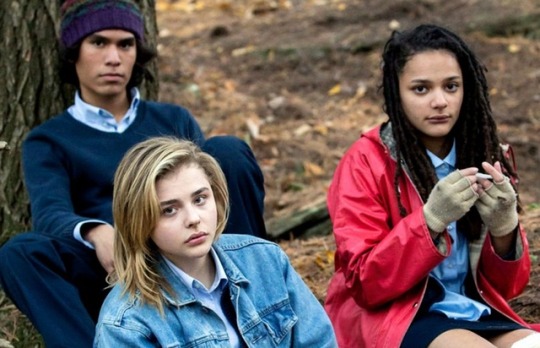
Latest story from https://movietvtechgeeks.com/miseducation-cameron-post-wins-top-prize-sundance-2018/
'Miseducation of Cameron Post' wins top prize at Sundance 2018
Now that 2018 Sundance Film Festival is officially over, the awards have now all be dlivered with top prizes going to The Miseducation of Cameron Post, Kailash, Of Fathers and Sons, and Butterflies While many thought it was a weak lineup of films in the festival, I enjoyed everything I saw, even those that weren't as strong like Robert Pattinson's latest. But that's what film festivals are all about; see films you probably would have missed otherwise. Many won't go on to greatness, but finding that diamond in the rough is what makes it so exciting to me. So below is the complete list of winners. After 10 days and 123 feature films, the 2018 Sundance Film Festival's Awards Ceremony took place tonight, with host Jason Mantzoukas emceeing and jurors presenting 28 prizes for feature filmmaking in Park City, Utah. Honorees, named in total below, represent new achievements in global independent storytelling. Bold, intimate, and humanizing stories prevailed across categories, with Grand Jury Prizes awarded to The Miseducation of Cameron Post (U.S. Dramatic), Kailash (U.S. Documentary), Of Fathers and Sons (World Cinema Documentary) and Butterflies (World Cinema Dramatic). "From the beginning, the purpose of the Sundance Film Festival has been to support artists and their stories," said Sundance Institute President and Founder Robert Redford, "and this year, our mission seemed especially relevant. Supporting independent voices, and listening to the stories they tell, has never been more necessary." "The scope and scale of this year's Festival -- films, events, conversations -- were invigorating," said Keri Putnam, the Institute's Executive Director. "I can't wait to see how our incredible community will leverage these ten days of connection and inspiration to make art and change in the coming year." "This Festival has been extraordinary," said John Cooper, Sundance Film Festival Director. "It's been a pleasure to stand shoulder-to-shoulder with these artists, and to see their work charm, challenge and galvanize its first audiences." The awards ceremony marked the culmination of the 2018 Festival, where 123 feature-length and 69 short films — selected from 13,468 submissions — were showcased in Park City, Salt Lake City and Sundance, Utah, alongside work in the new Indie Episodic category, panels, music and New Frontier. The ceremony was live-streamed; video is available at youtube.com/sff. This year's jurors, invited in recognition of their accomplishments in the arts, technical craft and visionary storytelling, deliberated extensively before presenting awards from the stage; this year's jurors were Barbara Chai, Simon Chinn, Chaz Ebert, Ezra Edelman, Matt Holzman, Rachel Morrison, Jada Pinkett Smith, Octavia Spencer, Michael Stuhlbarg, Joe Swanberg, Hanaa Issa, Ruben Östlund, Michael J. Werner, Joslyn Barnes, Billy Luther, Paulina Suarez, and Ru Paul Charles. A new award voted on by audiences, Festival Favorite, will be announced in the coming days. Feature film award winners in previous years include: I don't feel at home in this world anymore., Weiner, Whiplash, Fruitvale Station, Beasts of the Southern Wild, Twenty Feet from Stardom, Searching for Sugarman, The Square, Me and Earl and the Dying Girl, Cartel Land, The Wolf Pack, The Diary of a Teenage Girl, Dope, Dear White People, The Cove and Man on Wire. 2018 SUNDANCE FILM FESTIVAL FEATURE FILM AWARDS The U.S. Grand Jury Prize: Documentary was presented by Simon Chin to: Kailash / U.S.A. (Director: Derek Doneen, Producers: Davis Guggenheim, Sarah Anthony) — As a young man, Kailash Satyarthi promised himself that he would end child slavery in his lifetime. In the decades since, he has rescued more than eighty thousand children and built a global movement. This intimate and suspenseful film follows one man's journey to do what many believed was impossible. The U.S. Grand Jury Prize: Dramatic was presented to: The Miseducation of Cameron Post / U.S.A. (Director: Desiree Akhavan, Screenwriters: Desiree Akhavan, Cecilia Frugiuele, Producers: Cecilia Frugiuele, Jonathan Montepare, Michael B. Clark, Alex Turtletaub) — 1993: after being caught having sex with the prom queen, a girl is forced into a gay conversion therapy center. Based on Emily Danforth's acclaimed and controversial coming-of-age novel. Cast: Chloë Grace Moretz, Sasha Lane, Forrest Goodluck, John Gallagher Jr., Jennifer Ehle. The World Cinema Grand Jury Prize: Documentary was presented by Joselyn Barnes to: Of Fathers and Sons / Germany, Syria, Lebanon, Qatar (Director: Talal Derki, Producers: Ansgar Frerich, Eva Kemme, Tobias N. Siebert, Hans Robert Eisenhauer) — Talal Derki returns to his homeland where he gains the trust of a radical Islamist family, sharing their daily life for over two years. His camera focuses on Osama and his younger brother Ayman, providing an extremely rare insight into what it means to grow up in an Islamic Caliphate. The World Cinema Grand Jury Prize: Dramatic was presented by Ruben Ostlund to: Butterflies / Turkey (Director and screenwriter: Tolga Karaçelik, Producers: Tolga Karaçelik, Diloy Gülün, Metin Anter) — In the Turkish village of Hasanlar, three siblings who neither know each other nor anything about their late father, wait to bury his body. As they start to find out more about their father and about each other, they also start to know more about themselves. The Audience Award: U.S. Documentary, Presented by Acura was presented to: The Sentence /U.S.A. (Director: Rudy Valdez, Producers: Sam Bisbee, Jackie Kelman Bisbee) — Cindy Shank, mother of three, is serving a 15-year sentence in federal prison for her tangential involvement with a Michigan drug ring years earlier. This intimate portrait of mandatory minimum drug sentencing's devastating consequences, captured by Cindy's brother, follows her and her family over the course of ten years. The Audience Award: U.S. Dramatic, Presented by Acura was presented to: Burden / U.S.A. (Director and screenwriter: Andrew Heckler, Producers: Robbie Brenner, Jincheng, Bill Kenwright) — After opening a KKK shop, Klansman Michael Burden falls in love with a single mom who forces him to confront his senseless hatred. After leaving the Klan and with nowhere to turn, Burden is taken in by an African-American reverend, and learns tolerance through their combined love and faith.Cast: Garrett Hedlund, Forest Whitaker, Andrea Riseborough, Tom Wilkinson, Usher Raymond. The Audience Award: World Cinema Documentary was presented to: This Is Home / U.S.A., Jordan (Director: Alexandra Shiva, Producers: Lindsey Megrue, Alexandra Shiva) — This is an intimate portrait of four Syrian families arriving in Baltimore, Maryland and struggling to find their footing. With eight months to become self-sufficient, they must forge ahead to rebuild their lives. When the travel ban adds further complications, their strength and resilience are put to the test. The Audience Award: World Cinema Dramatic was presented to: The Guilty / Denmark (Director: Gustav Möller, Screenwriters: Gustav Möller, Emil Nygaard Albertsen, Producer: Lina Flint) — Alarm dispatcher Asger Holm answers an emergency call from a kidnapped woman; after a sudden disconnection, the search for the woman and her kidnapper begins. With the phone as his only tool, Asger enters a race against time to solve a crime that is far bigger than he first thought. Cast: Jakob Cedergren, Jessica Dinnage, Johan Olsen, Omar Shargawi. The Audience Award: NEXT, Presented by Adobe was presented to: Search / U.S.A. (Director: Aneesh Chaganty, Screenwriters: Aneesh Chaganty, Sev Ohanian, Producers: Timur Bekmambetov, Sev Ohanian, Adam Sidman, Natalie Qasabian) — After his 16-year-old daughter goes missing, a desperate father breaks into her laptop to look for clues to find her. A thriller that unfolds entirely on computer screens. Cast: John Cho, Debra Messing. The Directing Award: U.S. Documentary was presented by Ezra Edelman to: Alexandria Bombach for her film On Her Shoulders / U.S.A. (Director: Alexandria Bombach, Producers: Hayley Pappas, Brock Williams) — Nadia Murad, a 23-year-old Yazidi, survived genocide and sexual slavery committed by ISIS. Repeating her story to the world, this ordinary girl finds herself thrust onto the international stage as the voice of her people. Away from the podium, she must navigate bureaucracy, fame and people's good intentions. The Directing Award: U.S. Dramatic was presented to: Sara Colangelo, for her film The Kindergarten Teacher / U.S.A. (Director and screenwriter: Sara Colangelo, Producers: Talia Kleinhendler, Osnat Handelsman-Keren, Maggie Gyllenhaal, Celine Rattray, Trudie Styler) — When a Staten Island kindergarten teacher discovers what may be a gifted five year-old student in her class, she becomes fascinated and obsessed with the child-- spiraling downward on a dangerous and desperate path in order to nurture his talent. Cast: Maggie Gyllenhaal, Parker Sevak, Rosa Salazar, Anna Barynishikov, Michael Chernus, Gael Garcia Bernal. The Directing Award: World Cinema Documentary was presented by Paulina Suarez to: Sandi Tan, for her film Shirkers / U.S.A. (Director and screenwriter: Sandi Tan, Producers: Sandi Tan, Jessica Levin, Maya Rudolph) — In 1992, teenager Sandi Tan shot Singapore's first indie road movie with her enigmatic American mentor Georges – who then vanished with all the footage. Twenty years later, the 16mm film is recovered, sending Tan, now a novelist in Los Angeles, on a personal odyssey in search of Georges' vanishing footprints. The Directing Award: World Cinema Dramatic was presented by Michael J. Werner to: Ísold Uggadóttir, for her film And Breathe Normally / Iceland, Sweden, Belgium (Director and screenwriter: Ísold Uggadóttir, Producers: Skúli Malmquist, Diana Elbaum, Annika Hellström, Lilja Ósk Snorradóttir, Inga Lind Karlsdóttir) — At the edge of Iceland's Reykjanes peninsula, two women's lives will intersect – for a brief moment – while trapped in circumstances unforeseen. Between a struggling Icelandic mother and an asylum seeker from Guinea-Bissau, a delicate bond will form as both strategize to get their lives back on track. Cast: Kristín Thóra Haraldsdóttir, Babetida Sadjo, Patrik Nökkvi Pétursson. The Waldo Salt Screenwriting Award: U.S. Dramatic was presented to: Christina Choe, for her film NANCY / U.S.A. (Director and screenwriter: Christina Choe, Producers: Amy Lo, Michelle Cameron, Andrea Riseborough) — Blurring lines between fact and fiction, Nancy becomes increasingly convinced she was kidnapped as a child. When she meets a couple whose daughter went missing thirty years ago, reasonable doubts give way to willful belief – and the power of emotion threatens to overcome all rationality . Cast: Andrea Riseborough, J. Smith-Cameron, Steve Buscemi, Ann Dowd, John Leguizamo. A U.S. Documentary Special Jury Award for Creative Vision was presented by Matt Holzman to: Hale County This Morning, This Evening / U.S.A. (Director: RaMell Ross, Screenwriter: Maya Krinsky, Producers: Joslyn Barnes, RaMell Ross, Su Kim) — Composed of intimate and unencumbered moments of people in a community, this film is constructed in a form that allows the viewer an emotive impression of the Historic South - trumpeting the beauty of life and consequences of the social construction of race, while simultaneously a testament to dreaming. A U.S. Documentary Special Jury Award for Social Impact was presented by Chaz Ebert to: Crime + Punishment / U.S.A. (Director: Stephen Maing) — Over four years of unprecedented access, the story of a brave group of black and Latino whistleblower cops and one unrelenting private investigator who, amidst a landmark lawsuit, risk everything to expose illegal quota practices and their impact on young minorities. A U.S. Documentary Special Jury Award for Storytelling was presented by Chaz Ebert to: Three Identical Strangers /U.S.A. (Director: Tim Wardle, Producer: Becky Read) — New York,1980: three complete strangers accidentally discover that they're identical triplets, separated at birth. The 19-year-olds' joyous reunion catapults them to international fame, but also unlocks an extraordinary and disturbing secret that goes beyond their own lives - and could transform our understanding of human nature forever . A U.S. Documentary Special Jury Award for Breakthrough Filmmaking was presented by Barbara Chai to: Minding the Gap / U.S.A. (Director: Bing Liu, Producer: Diane Quon) — Three young men bond together to escape volatile families in their Rust Belt hometown. As they face adult responsibilities, unexpected revelations threaten their decade-long friendship. A U.S. Dramatic Special Jury Award for Outstanding First Feature was presented by Jada Pinkett Smith to: Monsters and Men / U.S.A. (Director and screenwriter: Reinaldo Marcus Green, Producers: Elizabeth Lodge Stepp, Josh Penn, Eddie Vaisman, Julia Lebedev, Luca Borghese) — This interwoven narrative explores the aftermath of a police killing of a black man. The film is told through the eyes of the bystander who filmed the act, an African-American police officer and a high-school baseball phenom inspired to take a stand. Cast: John David Washington, Anthony Ramos, Kelvin Harrison Jr., Chanté Adams, Nicole Beharie, Rob Morgan. A U.S. Dramatic Special Jury Award for Excellence in Filmmaking was presented by Michael Stulhbarg to: I Think We're Alone Now / U.S.A. (Director: Reed Morano, Screenwriter: Mike Makowsky, Producers: Fred Berger, Brian Kavanaugh-Jones, Fernando Loureiro, Roberto Vasconcellos, Peter Dinklage, Mike Makowsky) — The apocalypse proves a blessing in disguise for one lucky recluse – until a second survivor arrives with the threat of companionship. Cast: Peter Dinklage, Elle Fanning. A U.S. Dramatic Special Jury Award for Achievement in Acting was presented by Michael Stulhbarg to: Benjamin Dickey, for BLAZE /U.S.A. (Director: Ethan Hawke, Screenwriters: Ethan Hawke, Sybil Rosen, Producers: Jake Seal, John Sloss, Ryan Hawke, Ethan Hawke) — A reimagining of the life and times of Blaze Foley, the unsung songwriting legend of the Texas Outlaw Music movement; he gave up paradise for the sake of a song. Cast: Benjamin Dickey, Alia Shawkat, Josh Hamilton, Charlie Sexton. A World Cinema Documentary Special Jury Award was presented by Billy Luther to: Stephen Loveridge and M.I.A., for MATANGI / MAYA / M.I.A. / Sri Lanka, United Kingdom, U.S.A. (Director: Stephen Loveridge, Producers: Lori Cheatle, Andrew Goldman, Paul Mezey) — Drawn from a never before seen cache of personal footage spanning decades, this is an intimate portrait of the Sri Lankan artist and musician who continues to shatter conventions. A World Cinema Documentary Special Jury Award for Editing was presented by Paulina Suarez to: Editors Maxim Pozdorovkin and Matvey Kulakov, for Our New President/ Russia, U.S.A. (Director: Maxim Pozdorovkin, Producers: Maxim Pozdorovkin, Joe Bender, Charlotte Cook) — The story of Donald Trump's election told entirely through Russian propaganda. By turns horrifying and hilarious, the film is a satirical portrait of Russian media that reveals an empire of fake news and the tactics of modern-day information warfare. A World Cinema Documentary Special Jury Award for Cinematography was presented by Billy Luther to: Cinematographers Maxim Arbugaev and Peter Indergand, for Genesis 2.0 / Switzerland (Directors: Christian Frei, Maxim Arbugaev, Producer: Christian Frei) — On the remote New Siberian Islands in the Arctic Ocean, hunters search for tusks of extinct mammoths. When they discover a surprisingly well-preserved mammoth carcass, its resurrection will be the first manifestation of the next great technological revolution: genetics. It may well turn our world upside down. A World Cinema Dramatic Special Jury Award for Screenwriting was presented by Michael J. Werner to: Screenwriters Julio Chavezmontes and Sebastián Hofmann, for Time Share (Tiempo Compartido) / Mexico, Netherlands (Director: Sebastián Hofmann, Screenwriters: Julio Chavezmontes, Sebastián Hofmann, Producer: Julio Chavezmontes) — Two haunted family men join forces in a destructive crusade to rescue their families from a tropical paradise, after becoming convinced that an American timeshare conglomerate has a sinister plan to take their loved ones away. A World Cinema Dramatic Special Jury Award for Acting was presented by Hanaa Issa to: Valeria Bertuccelli, for The Queen of Fear / Argentina, Denmark (Directors: Valeria Bertuccelli, Fabiana Tiscornia, Screenwriter: Valeria Bertuccelli, Producers: Benjamin Domenech, Santiago Gallelli, Matias Roveda, Juan Vera, Juan Pablo Galli, Christian Faillace) — Only one month left until the premiere of The Golden Time, the long-awaited solo show by acclaimed actress Robertina. Far from focused on the preparations for this new production, Robertina lives in a state of continuous anxiety that turns her privileged life into an absurd and tumultuous landscape. Cast: Valeria Bertuccelli, Diego Velázquez, Gabriel Eduardo "Puma" Goity, Darío Grandinetti. A World Cinema Dramatic Special Jury Award for Ensemble Acting was presented by Hanaa Issa to: Dead Pigs / China (Director and screenwriter: Cathy Yan, Producers: Clarissa Zhang, Jane Zheng, Zhangke Jia, Mick Aniceto, Amy Aniceto) — A bumbling pig farmer, a feisty salon owner, a sensitive busboy, an expat architect and a disenchanted rich girl converge and collide as thousands of dead pigs float down the river towards a rapidly-modernizing Shanghai, China. Based on true events . Cast: Vivian Wu, Haoyu Yang, Mason Lee, Meng Li, David Rysdahl. The NEXT Innovator Prize was announced as a tie, and was presented by juror RuPaul Charles to two films: Night Comes On / U.S.A. (Director: Jordana Spiro, Screenwriters: Jordana Spiro, Angelica Nwandu, Producers: Jonathan Montepare, Alvaro R. Valente, Danielle Renfrew Behrens) — Angel LaMere is released from juvenile detention on the eve of her 18th birthday. Haunted by her past, she embarks on a journey with her 10 year-old sister that could destroy their future. Cast: Dominique Fishback, Tatum Hall, John Earl Jelks, Max Casella, James McDaniel. We the Animals / U.S.A. (Director: Jeremiah Zagar, Screenwriters: Daniel Kitrosser, Jeremiah Zagar, Producers: Jeremy Yaches, Christina D. King, Andrew Goldman, Paul Mezey) — Us three, us brothers, us kings. Manny, Joel and Jonah tear their way through childhood and push against the volatile love of their parents. As Manny and Joel grow into versions of their father and Ma dreams of escape, Jonah, the youngest, embraces an imagined world all his own. Cast: Raul Castillo, Sheila Vand, Evan Rosado, Isaiah Kristian, Josiah Gabriel. The following awards were presented at separate ceremonies at the Festival: SHORT FILM AWARDS: Jury prizes and honorable mentions in short filmmaking were presented at a ceremony in Park City on January 23. The Short Film Grand Jury Prize was awarded to: Matria / Spain (Director and screenwriter: Director and screenwriter: Álvaro Gago). The Short Film Jury Award: U.S. Fiction was presented to: Hair Wolf / U.S.A. (Director and screenwriter: Director and screenwriter: Mariama Diallo). The Short Film Jury Award: International Fiction was presented to: Would You Look at Her / Macedonia (Director and screenwriter: Goran Stolevski). The Short Film Jury Award: Nonfiction was presented to: The Trader (Sovdagari) / Georgia (Director: Tamta Gabrichidze). The Short Film Jury Award: Animation was presented to: GLUCOSE / U.S.A. (Director and screenwriter: Jeron Braxton). Three Special Jury Awards without designation were presented to: Emergency / U.S.A. (Director: Carey Williams, Screenwriter: K.D. Dávila), Fauve / Canada (Director and screenwriter: Jérémy Comte) and For Nonna Anna / Canada (Director and screenwriter: Luis De Filippis). The Short Film jurors were Cherien Dabis, Shirley Manson and Chris Ware. The Short Film program is presented by YouTube. SUNDANCE INSTITUTE OPEN BORDERS FELLOWSHIP PRESENTED BY NETFLIX The recipients of Sundance Institute Open Borders Fellowship presented by Netflix, announced January 26, are three of the most exciting emerging filmmakers from the world cinema stage working in both narrative and nonfiction. The recipients are: Of Fathers and Sons (Syria) / Talal Derki Untitled (India) / Chaitanya Tamhane Night On Fire (Mexico) / Tatiana Huezo The Sundance Institute / NHK Award was presented to: His House(United Kingdom) / Remi Weekes. SUNDANCE INSTITUTE | ALFRED P. SLOAN FEATURE FILM PRIZE The 2018 Alfred P. Sloan Feature Film Prize, presented to an outstanding feature film about science or technology, was presented to Aneesh Chaganty and Sev Ohanian's Search . The filmmakers received a $20,000 cash award from Sundance Institute with support from the Alfred P. Sloan Foundation. SUNDANCE INSTITUTE | AMAZON STUDIOS PRODUCERS AWARDS Sev Ohanian received the 2018 Sundance Institute | Amazon Studios Producers Awards. The award recognizes bold vision and a commitment to continuing work as a creative producer in the independent space, and grants money (via the Sundance Institute Feature Film Program and Documentary Film Program) to emerging producers of films at the Sundance Film Festival.
Movie TV Tech Geeks News
0 notes
Photo

Latest story from https://movietvtechgeeks.com/alicia-witt-charles-martinet-panel-northern-fancon-panels/
Alicia Witt and Charles Martinet Northern FanCon panels
“It’s the end of the con as we know it …” Yes, Supernatural convention fan attendees will recognize that line from the final song that Louden Swain plays at Supernatural’s Creation conventions, a paraphrase of R.E.M.’s It’s the End of the World. However, it works. Day 3, the Sunday, saw even more great cosplay, a quick interview with Kevin Sorbo and Alicia Witt answering my question during her panel. As well -- who knew that Charles Martinet – Mario – was just so freakin’ funny! During one of the slow times for the actors, I was able to ask Kevin what he enjoyed most about meeting with fans. “Without fans, none of us have a career, it’s as simple as that. I don’t care if you’re Clint Eastwood or Tom Cruise, or a voiceover actor … if you don’t have people that enjoy your work, love what you do, you don’t have a career, it’s that simple. We’re salesmen, we really are. “I enjoy meeting with them, talking with them … I wouldn’t do these cons if I didn’t enjoy coming to them. Granted, we get paid and stuff like that, but at the same time I wouldn’t take the time to be away from my family and travel as much as I do if I didn’t enjoy it. I also get some interesting ideas from people of things that they like and it’s fun, people are great.” Unfortunately, the four times that I went to stand in line to chat with Kyle, his lineup was extremely busy. I have learned a lot about conducting interviews over this weekend, and one thing would definitely be to get the interviews with the more popular stars out of the way first. I think it would’ve been much easier on Friday. In any case, Charles Martinet’s panel was the first one that I attended. Go. Look up one of his panels on YouTube. I highly suggest it … the man is FUNNY! And he never stops talking! But this is a good thing – as everything he says is entertaining. He spoke about how he was chosen to be the voice of Mario (which was pitched as an Italian plumber from Brooklyn) and how his entire audition was talking about pasta – lots, and lots of pasta – and how pleased he was to still be doing the job 27 years later. [gallery size="medium" link="file" ids="46063,46064,46065"] One question I thought was interesting – it was on what Charles thought about the many off-colour memes to do with Mario and Lugio that are out there. [gallery columns="2" size="medium" ids="46066,46067,46068,46069"] His answer – and I paraphrase – was this. [gallery columns="2" size="medium" ids="46070,46071,46072,46073"] “I love that my creativity has bred so much more creativity in the world. I don’t agree with some of the content all the time, but I love the creativity.” I have to admit, my favourite part about Sunday was when Alicia Witt – who played Lily Sunder (in addition to much, much more, including being on the Walking Dead) answered my question. Not only did she remember my name, she had a beautiful answer to my question – “Do you think Lily ever forgave Castiel at the end?” [gallery columns="2" size="medium" link="file" ids="46074,46075,46076,46077"] That’s a really good question, and it’s something that I wondered myself. The writing on that show, as you know, is so good. I love that she said, “Revenge is all I’ve ever known, I don’t know who I am without it.” I just thought that was a beautifully honest response to Castiel’s question as to whether she could forgive me, and how he said, “If you ever find you haven’t, you can come find me.” I think she didn’t know what to say – this character experienced the worst possible and unfair loss 100 years earlier and all she could think to do was – and all you could really do in a situation like that I guess – is figure out how to exact revenge. She learned how to become immortal, or somewhat immortal, and she’s learned how to harness angel power, angel magic, which most humans don’t know how to do. I loved that response. I think she doesn’t know in that episode if she’s forgiven him. When Castiel decides to kill Isham for her that was not what she was expecting. Definitely not. She was prepared to kill everyone who had anything to do with killing her daughter and her husband, and then she’d be done. She would have then done what she came to do and my feeling was she was so overwhelmed with emotion when Castiel does that, that she isn’t sure what to say and what came out was fully honest. That she doesn’t know who she is without that. So she needed some time to consider if she has forgiven. I would think she would though. I think she saw the honesty in him. I certainly could, as Lily in that moment, I could see that he really felt remorse and that it hadn’t been his choice. I’d like to see more of her though! I’m really not so secretly hoping I get to come back as Lily. Unlike the Walking Dead, I didn’t die on Supernatural. I want to see Lily again. See what happened to her after that. [gallery columns="2" size="medium" link="file" ids="46082,46083,46084,46085"] I loved her relationship with the Jared and Jensen characters [Sam and Dean]; I really did. I liked that she said I don’t want to hurt any human. She was never going to be a threat to them. I love that they made a snap judgment and decided to trust her. She was just a cool character.” [gallery size="medium" link="file" ids="46086,46087,46088"] I want to thank Norm Coyne from Northern FanCon and Movie TV Tech Geeks for giving me the opportunity to attend this con as media – I’m already looking forward to next year!
Movie TV Tech Geeks News
0 notes